Below is a list of 50 rules for figurative sculpture, with an emphasis on using plasticine clay and targeting a bronze finished product. I have collected these rules over decades from teachers, books, and clay-under-finger-nails experience. To see my sculptures, please visit lanceglasserart.com. I will be continually updating this post, so bookmark it and check back often.
Armatures for Figurative Sculpture
Aluminum is good for making armatures, but wear gloves. You may need steel instead of aluminum for strength, especially for larger pieces. The weight of the clay increases as the cube of the size. That is why the lower legs of the dragon to the right are made of steel while the rest of the wire is made of aluminum. Note the galvanized pipe, a few of which were drilled and tapped. Epoxy putty is an alternative. The black wrap is made from defunct cut up bicycle tires.
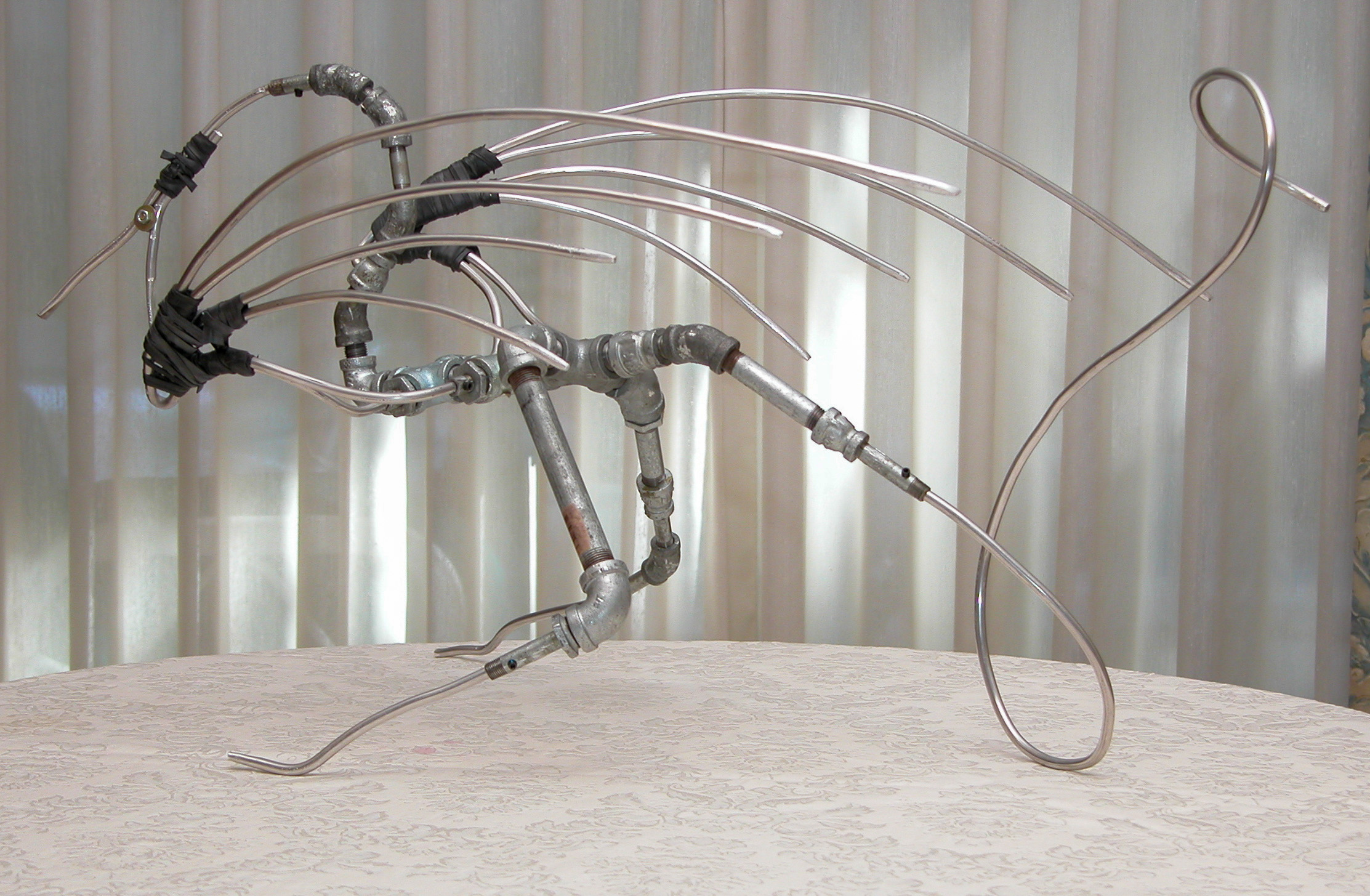
As goes the armature, so goes the sculpture. You should be able to see the gesture in the armature. Nearly impossible to fix later. Armature is shown on left and clay on right.
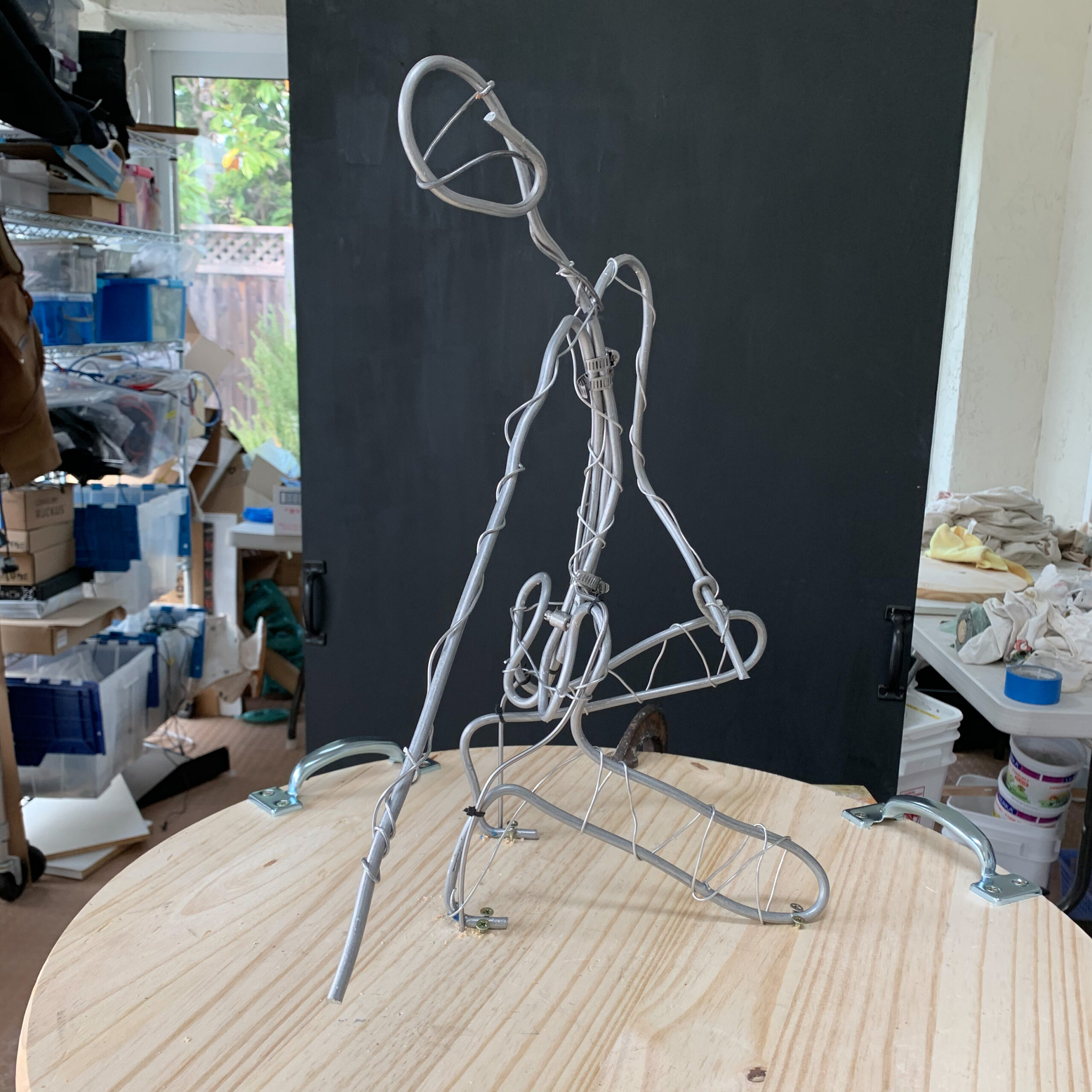
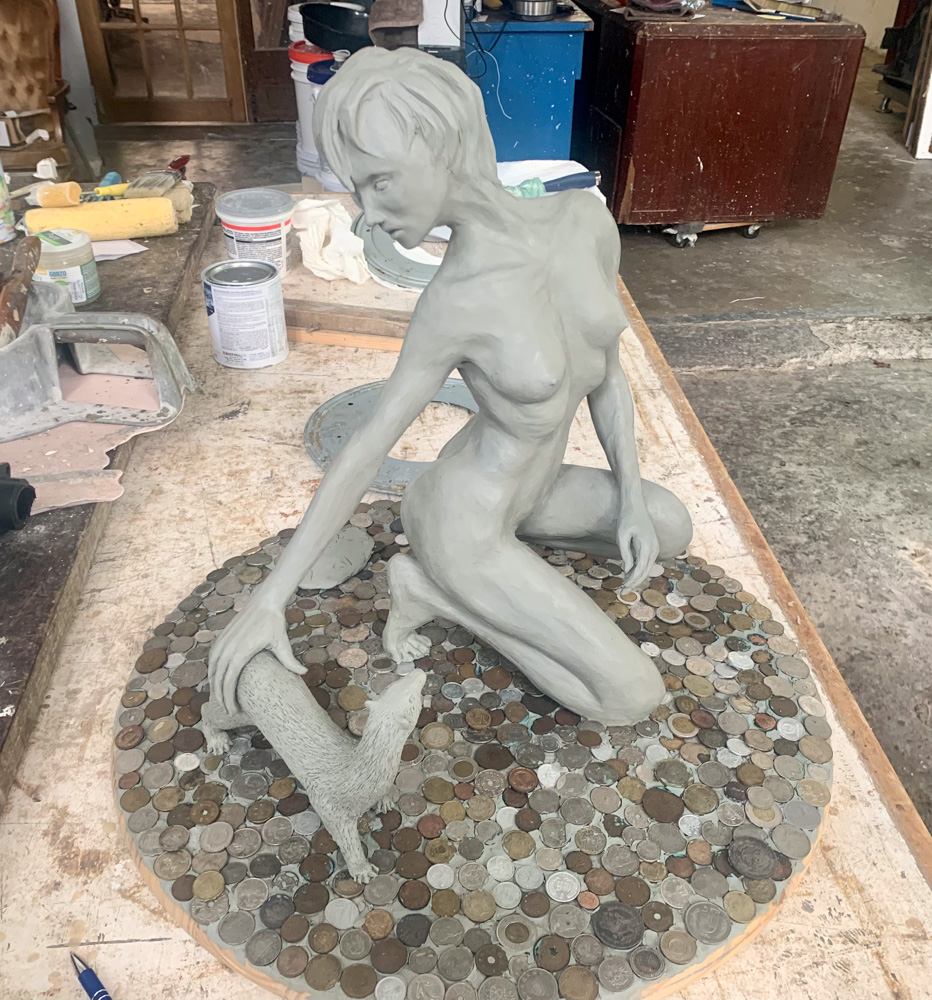
Sometimes the aluminum is stranded together. For instance, for a 36-inch sculpture, one could take three strands of 1/8th inch aluminum wire and wrap them together. This can be done by taking one set of ends and putting them in a vice while the other end goes into the chuck of a variable speed drill. Take care.
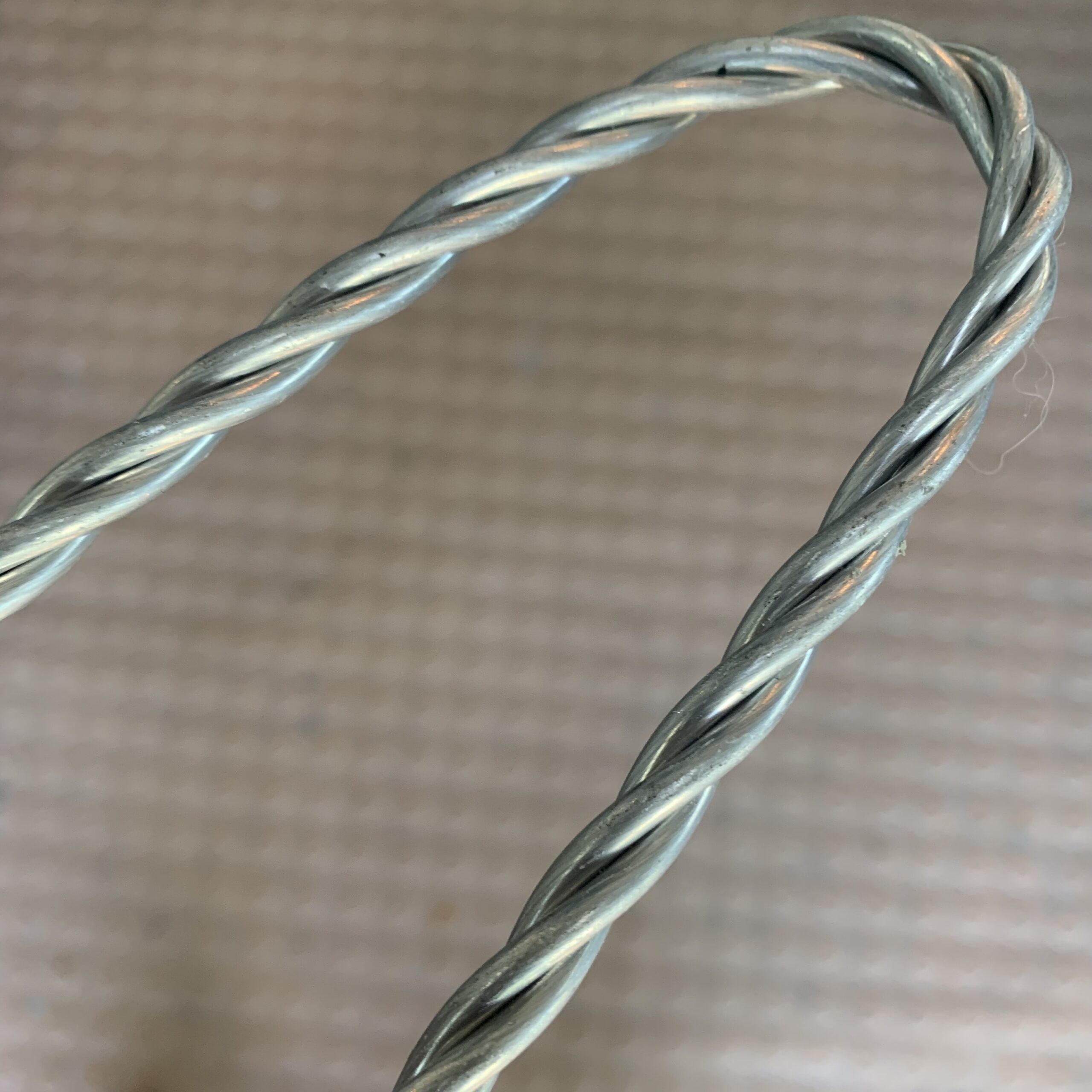
Some people wrap the basic armature in thin wire to increase the adhesion of the clay. This is essential for water-based clay. Note the hose clamps–very useful.
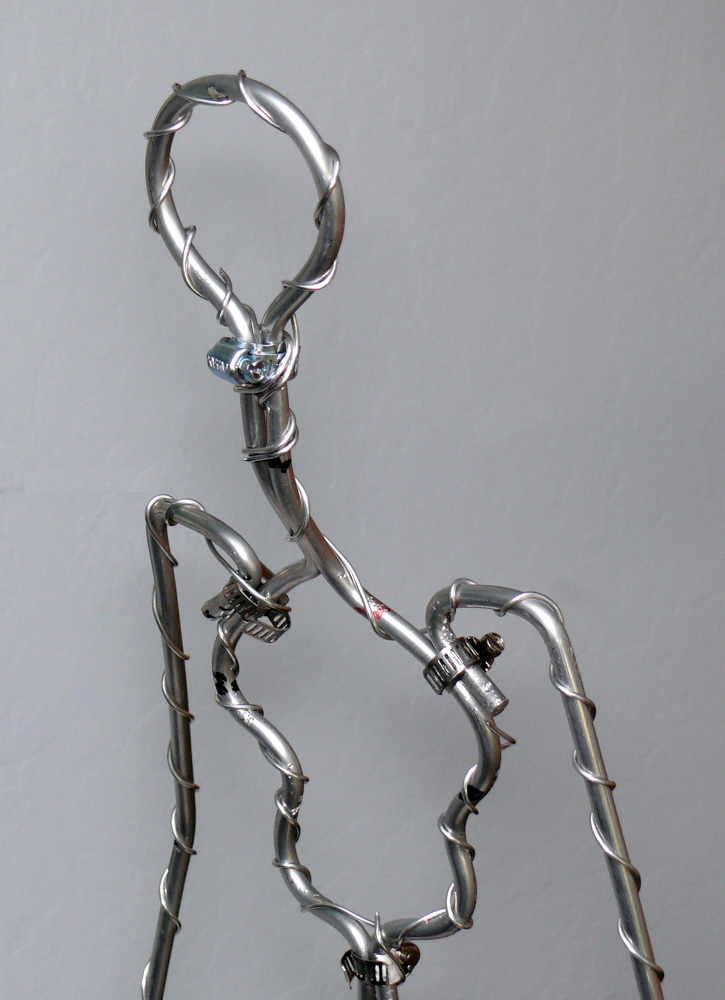
Gesture
Gesture harmony is created by the relationship between major lines and how different parts of the body connect. E.g., does the left arm line up with the right leg? With the tilt of the shoulders? Work on the relationships among the parts early.

Look for the long line of the body. The longest line often defines the gesture. Is one side of the body elongated/stretched and the other compressed? Tension vs relaxation? For art, gesture is more important than accuracy. The figure has rhythm lines that flow through the body like highways undulating through the mountains. Look for them and use them to unite the image. They are amazingly powerful.
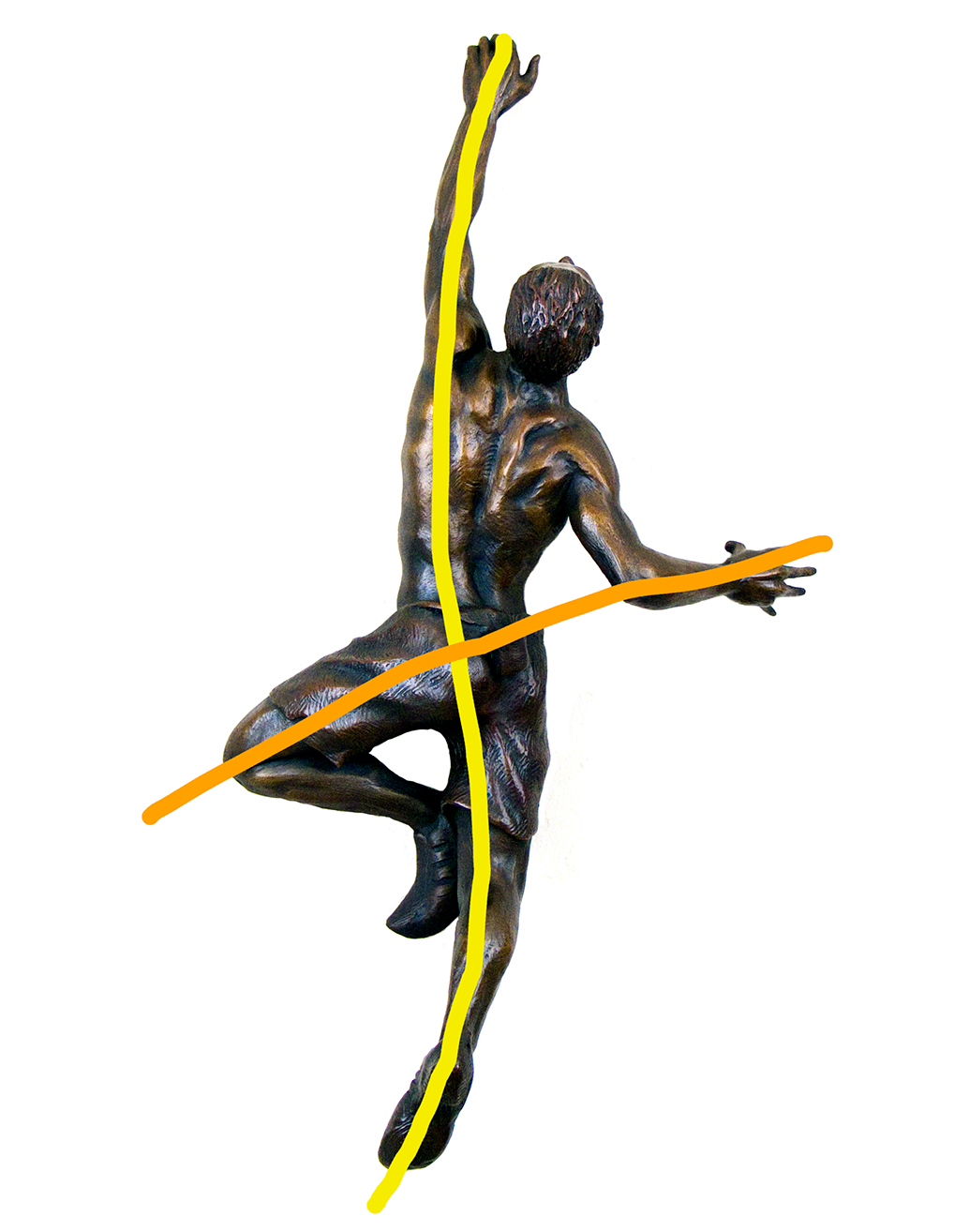
Initially, capturing the gesture is about getting the angles correct. For instance, if the model’s weight is mostly on one leg, that leg will not be vertical but rather slant inward under the center of gravity of the figure. The leg itself will not be straight like a rod, but rather the upper and lower leg will have their own angles; the pelvis will almost always be higher on the weight-bearing side and the corresponding shoulder is often tipped down. If you look at the figure from the top, some of the best poses have the plane of the torso at an angle to the plane of the pelvis.
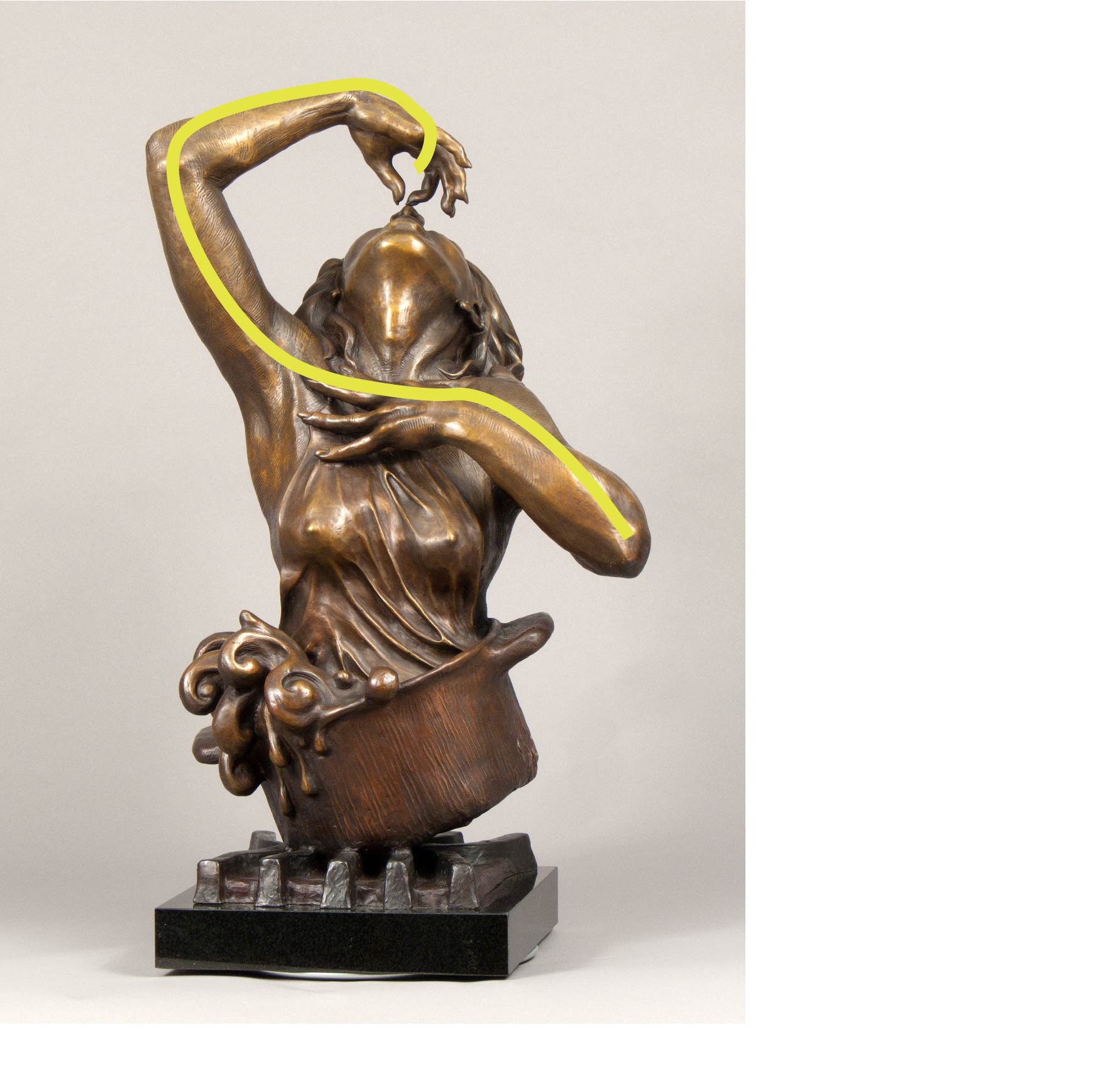
What are the relationships among the shapes as they flow into one another? Observe the plumb lines and line-ups of the forms. Architecturally, the weight-bearing leg is often the most important. Good places to drop a plumb line from are the pit of the neck or the 7th cervical vertebrae, which defines where the neck meets the rib cage. To build the figure, one can either measure measure-measure-measure or one can look for angles and relationships. In general, the sculpture will look more natural and beautiful if you construct it out of relationships and angles rather than engineer it out of measurements. Nevertheless, for measuring, proportional calipers are great. Another trick is to make the ratio between the model and the sculpture 2.54. Measure the model in inches and the sculpture should be that number of cm. There are 2.54 cm in an inch.
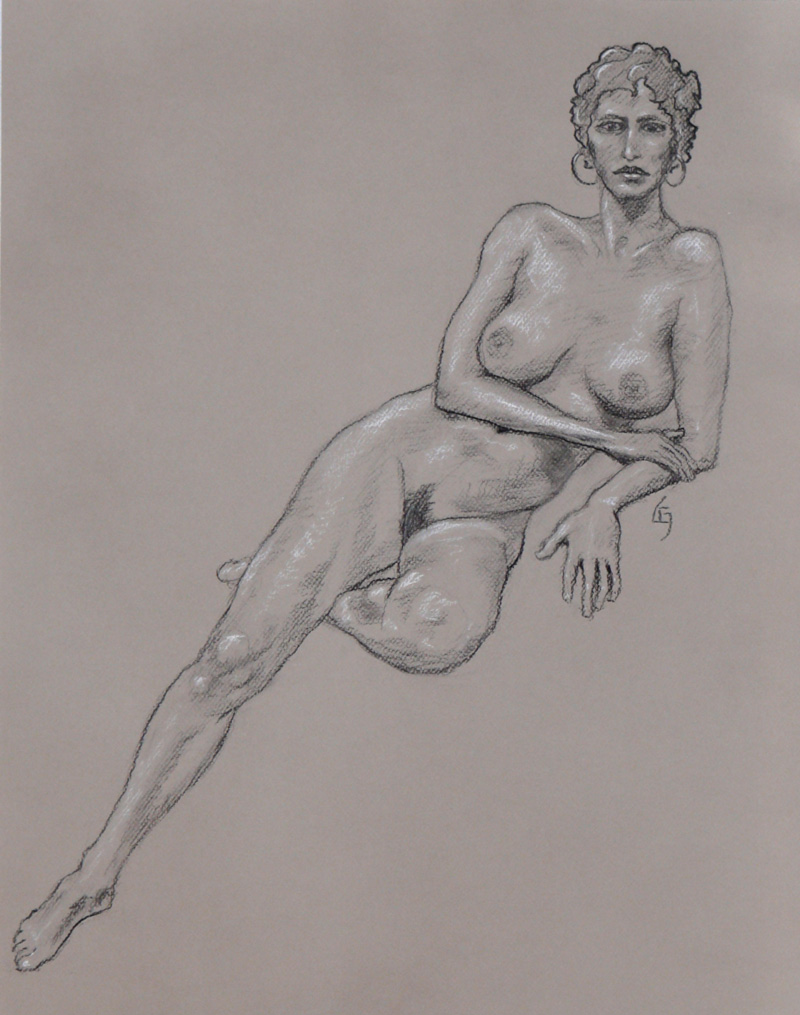
The difference between Egyptian and Greek art is the contrapposto pose where the hips tilt one way and the shoulders the other. The weight is on the higher hip. It is a gorgeous pose.
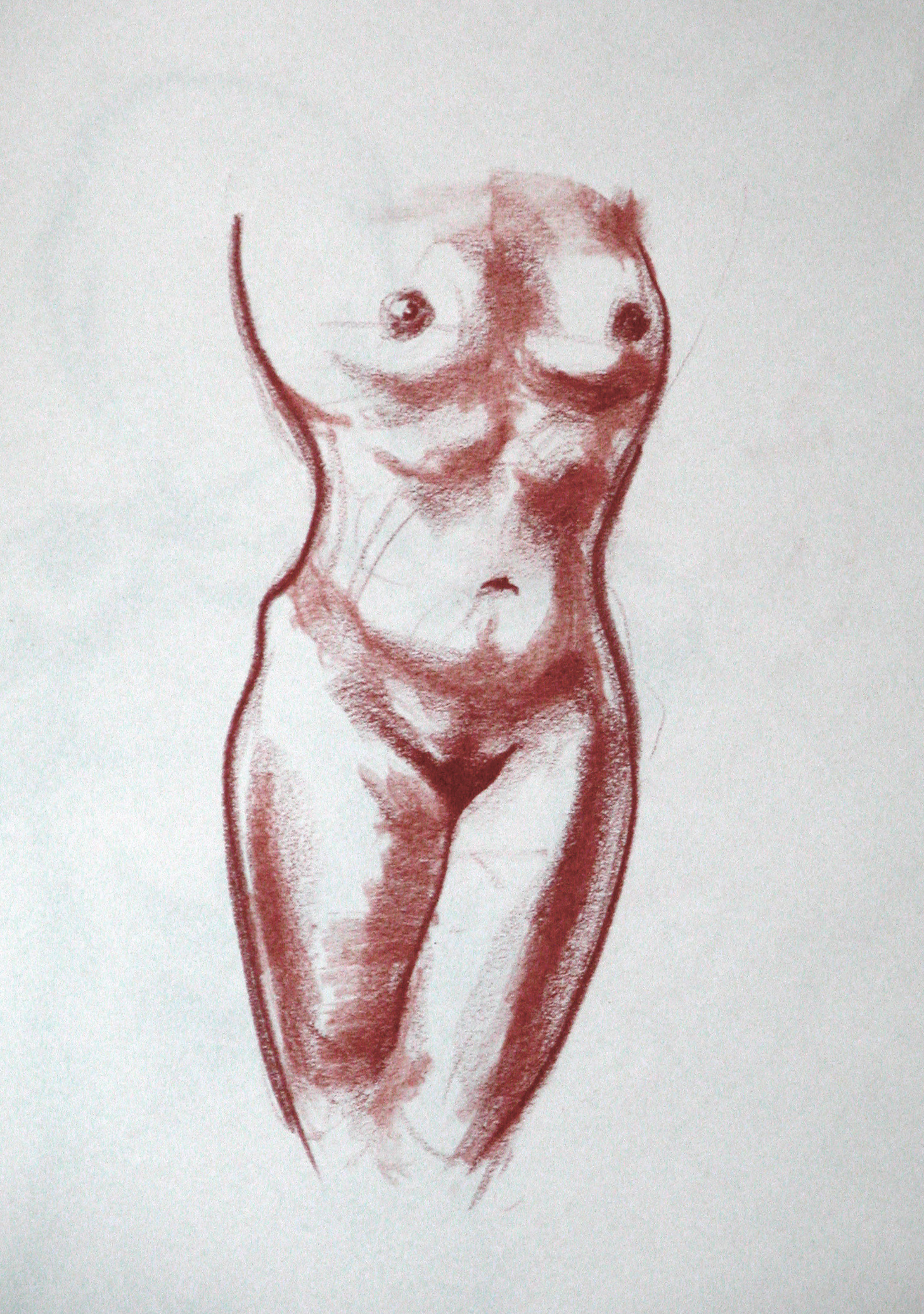
Be careful where the head is in relationship to the feet and the center of mass. A figure at rest has the head directly over the feet. Conversely, if you want to show motion, don’t allow the head to be exactly over the feet.
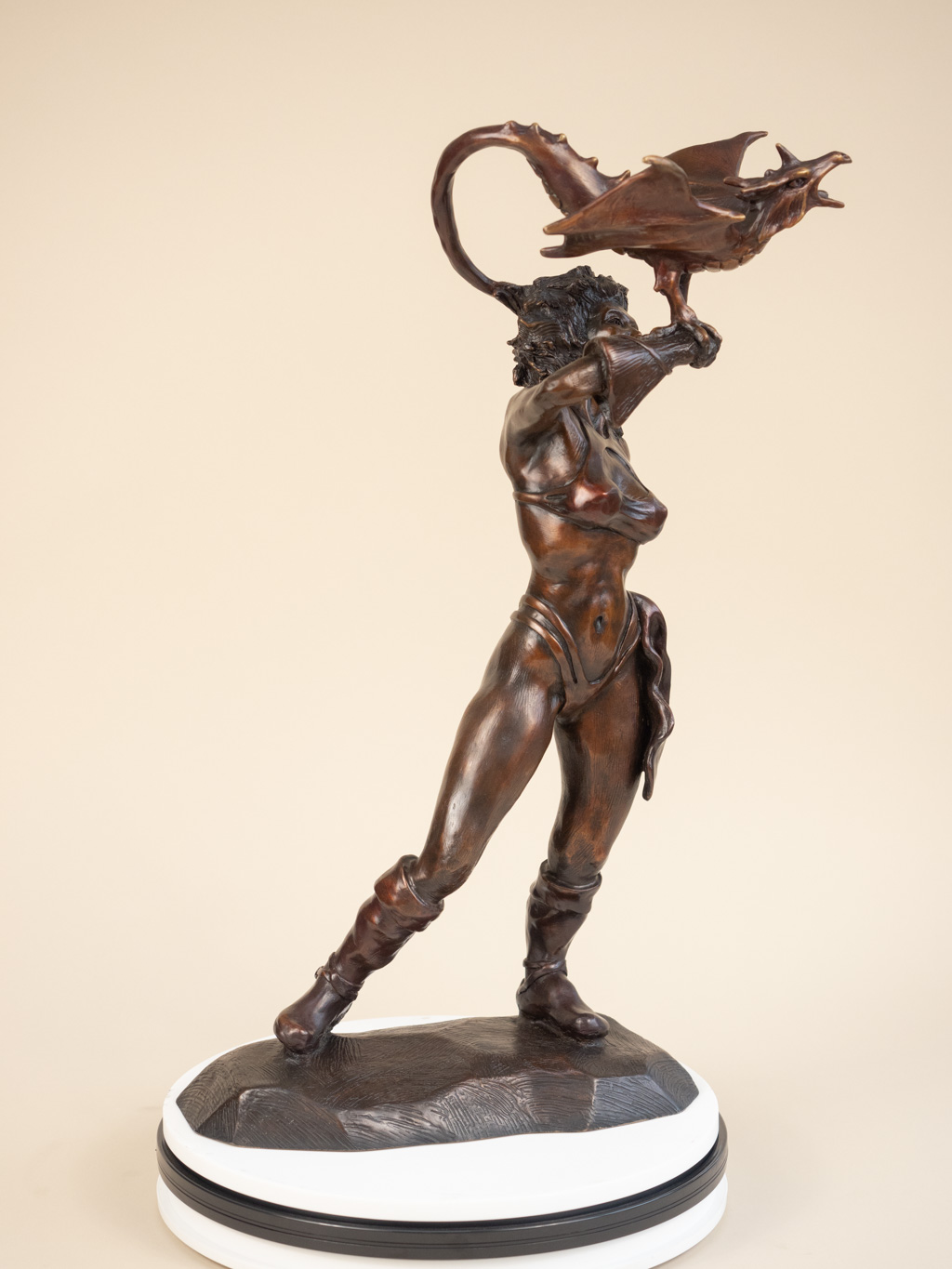
Study a book on body language.
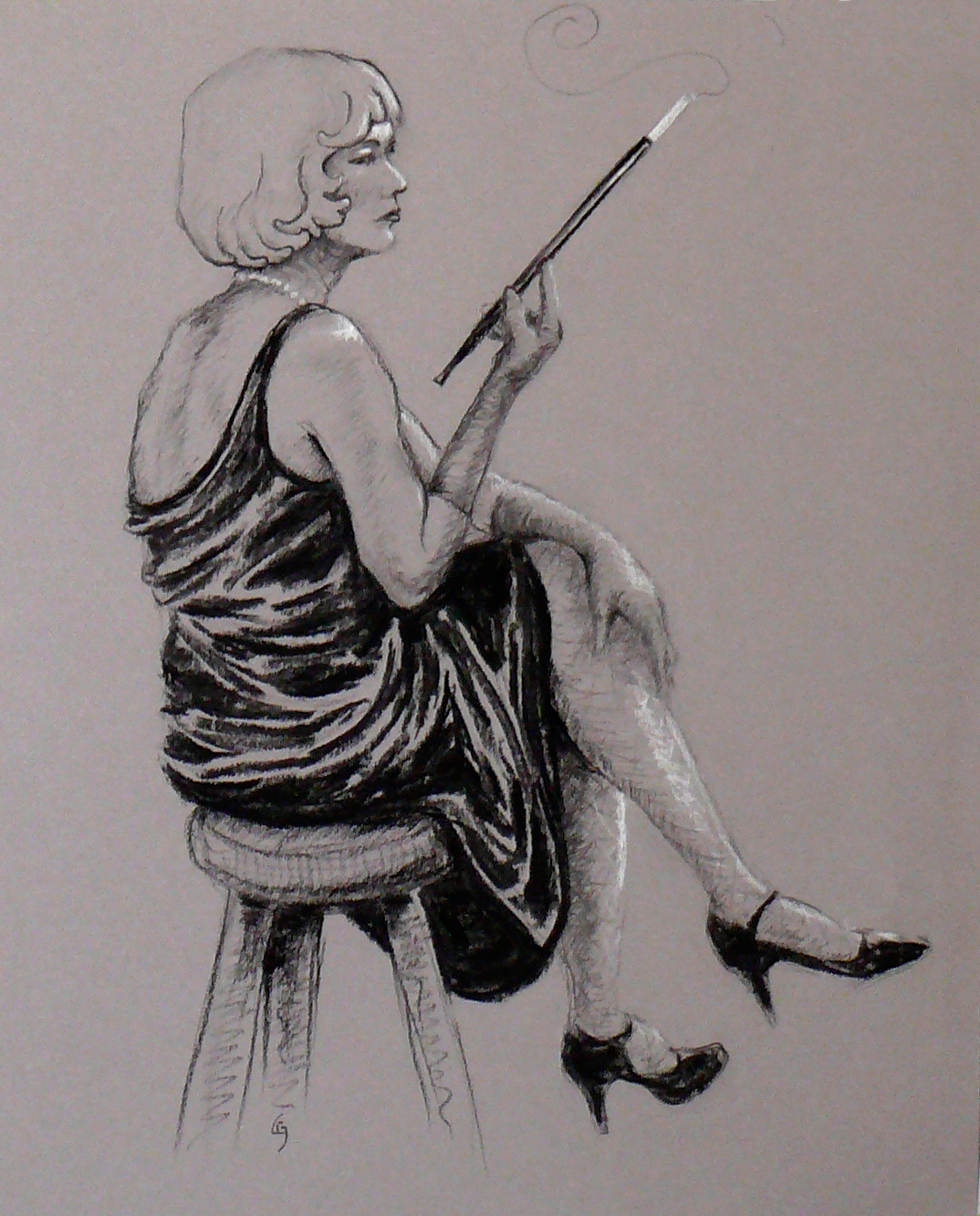
If you want a figure to look sensuous, everything that can bend should bend.
If you want her to look erotic, have her touching herself and bending her neck as if submissively offering it to a vampire. Bedroom eyes have the dilated pupils. Scant clingy clothes can increase eroticism and make the model look more naked than naked.
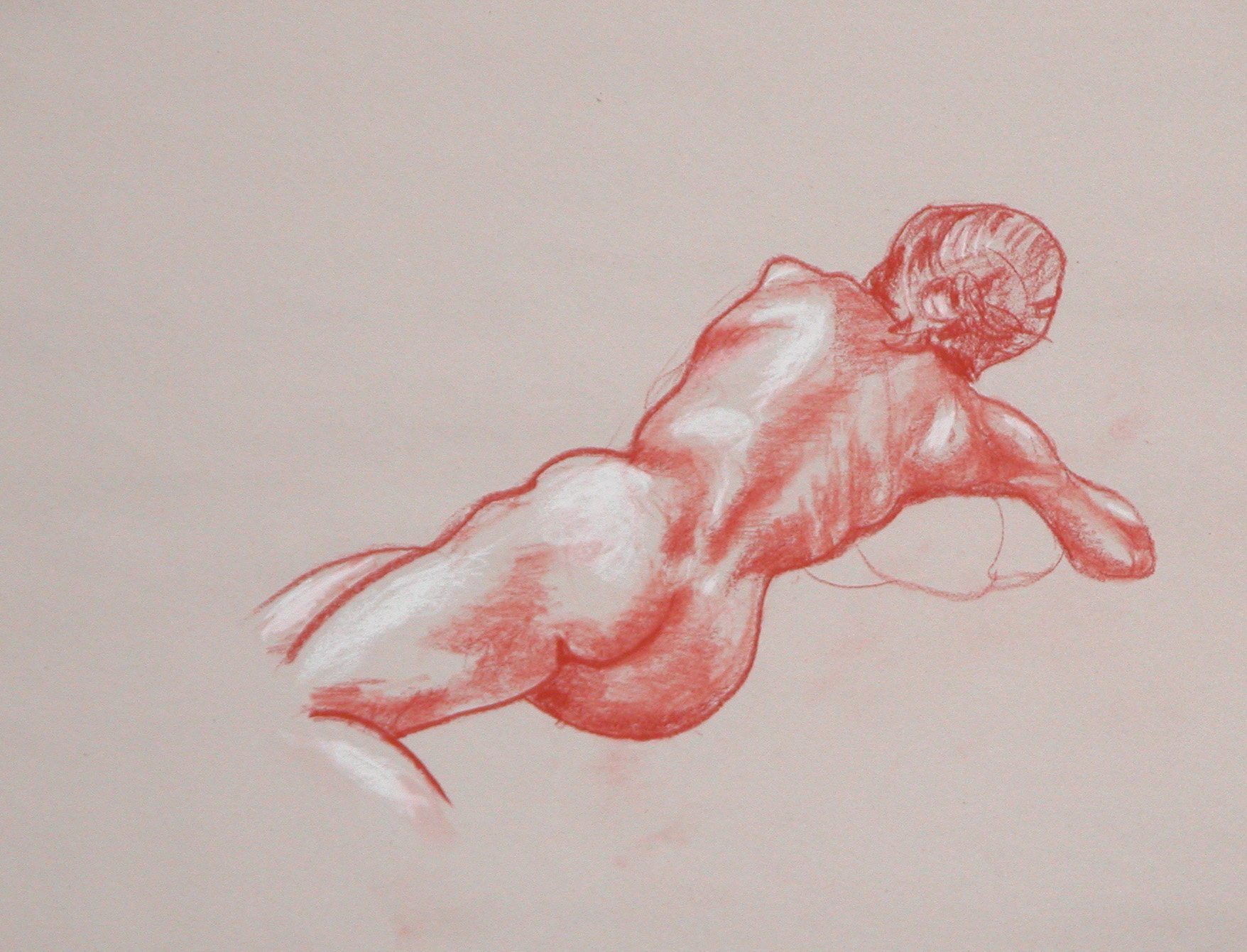
The face is the only part of the human figure that has muscles whose sole purpose is to convey expression, emotion. Eyes crinkle in the corners when the laughter is real. Micro-expressions are important. Sports photos are a good source of captured micro expressions.
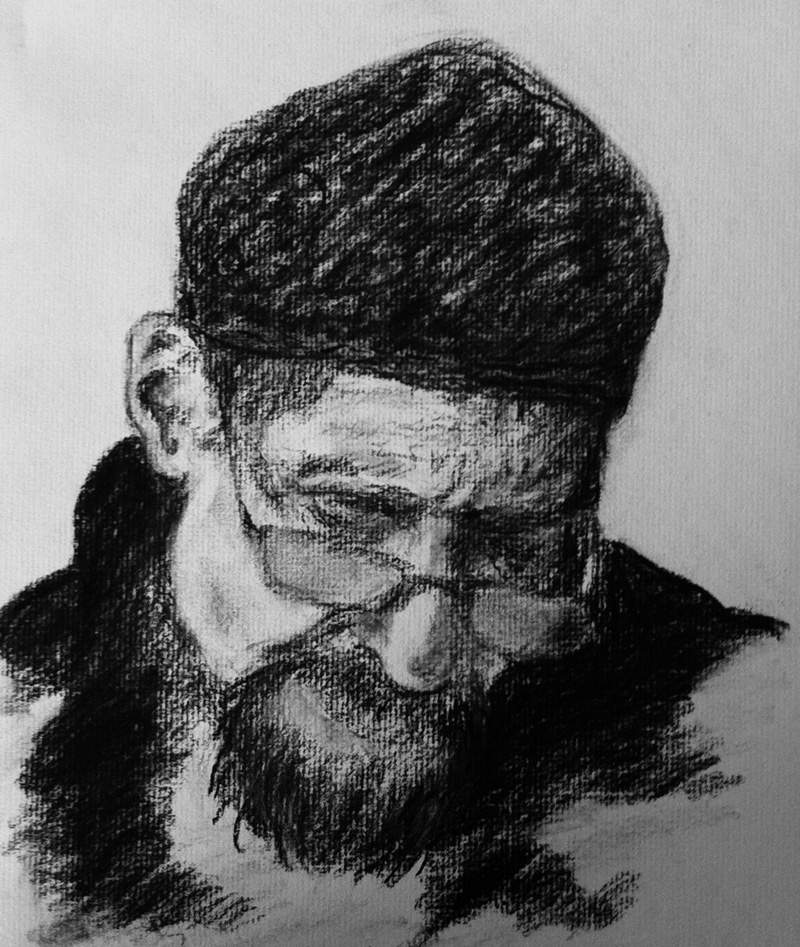
Anatomy for Figurative Sculpture
The human body has three containers: head, ribs, pelvis. These are rigid and independent of the pose unless there has been a terrible accident. The shoulders and breasts are not containers and are not rigid.
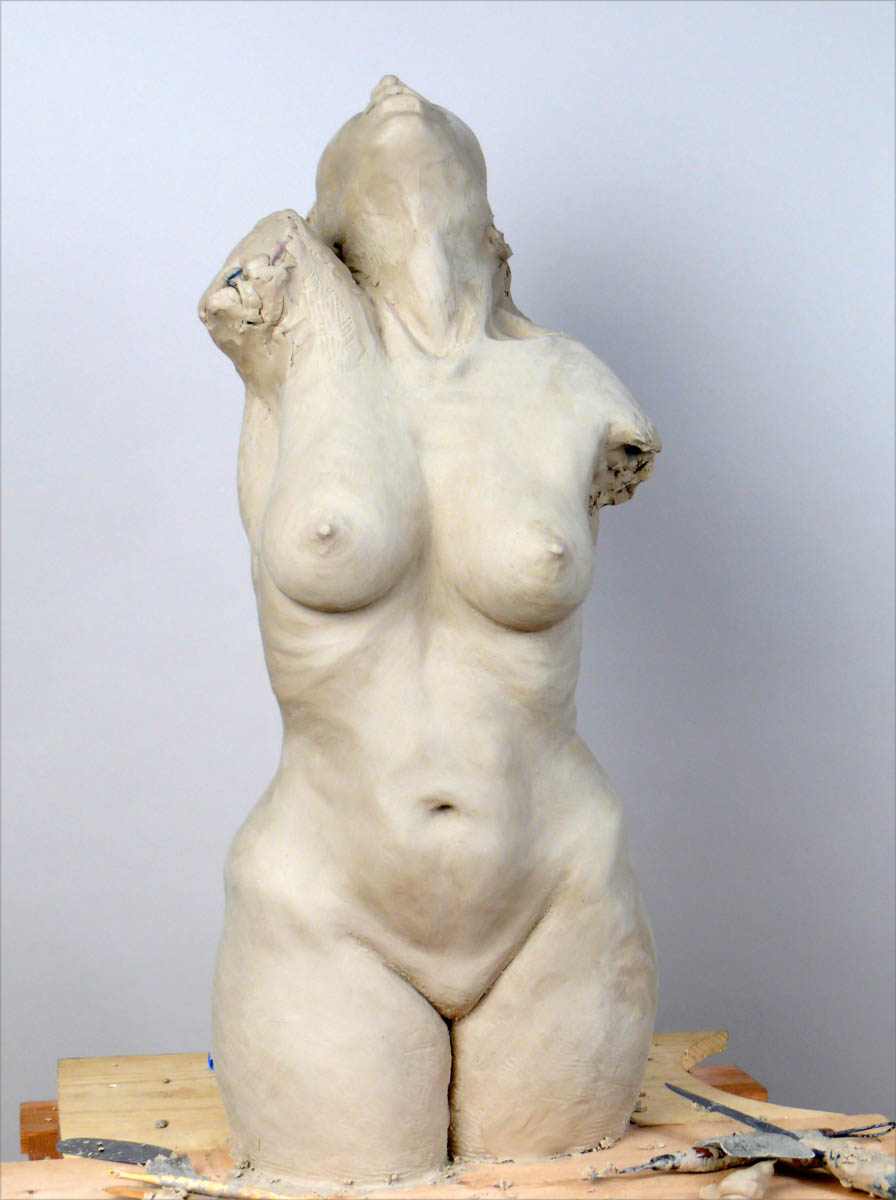
Alternate back and forth between sculpting what you see and what you know (from your anatomy or structure studies). The spacing and positioning of the features define the character. Work the major shapes and relationships first and details later. Don’t get caught detailing some volume that you later discover has a bigger problem. Work from top to bottom and work from major shapes to minor ones. It is good to try to keep the overall sculpture at about the same level of detailing. An exception to this is, of course, if you plan on not putting in the details (or even major features) in some volume to force the viewers to imagine them for themselves.
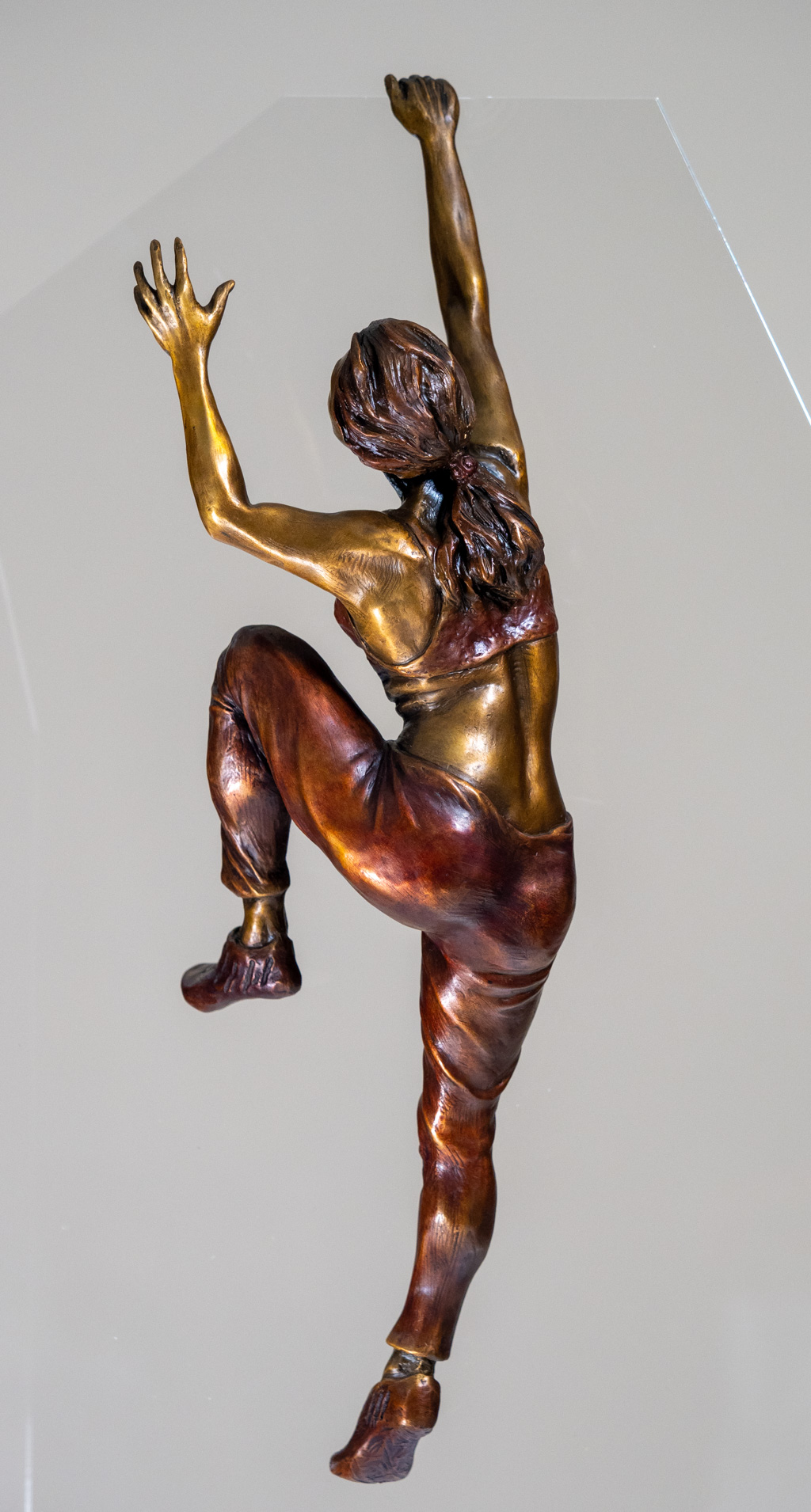
Large hands and feet are powerful. An extra-large penis is just distracting. I did, however, hear of a sculpture of a satyr in Italy with interchangeable erections of different sizes. Brought to you by the same culture that can come up with the term “extra virgin”? What kind of party are you throwing?
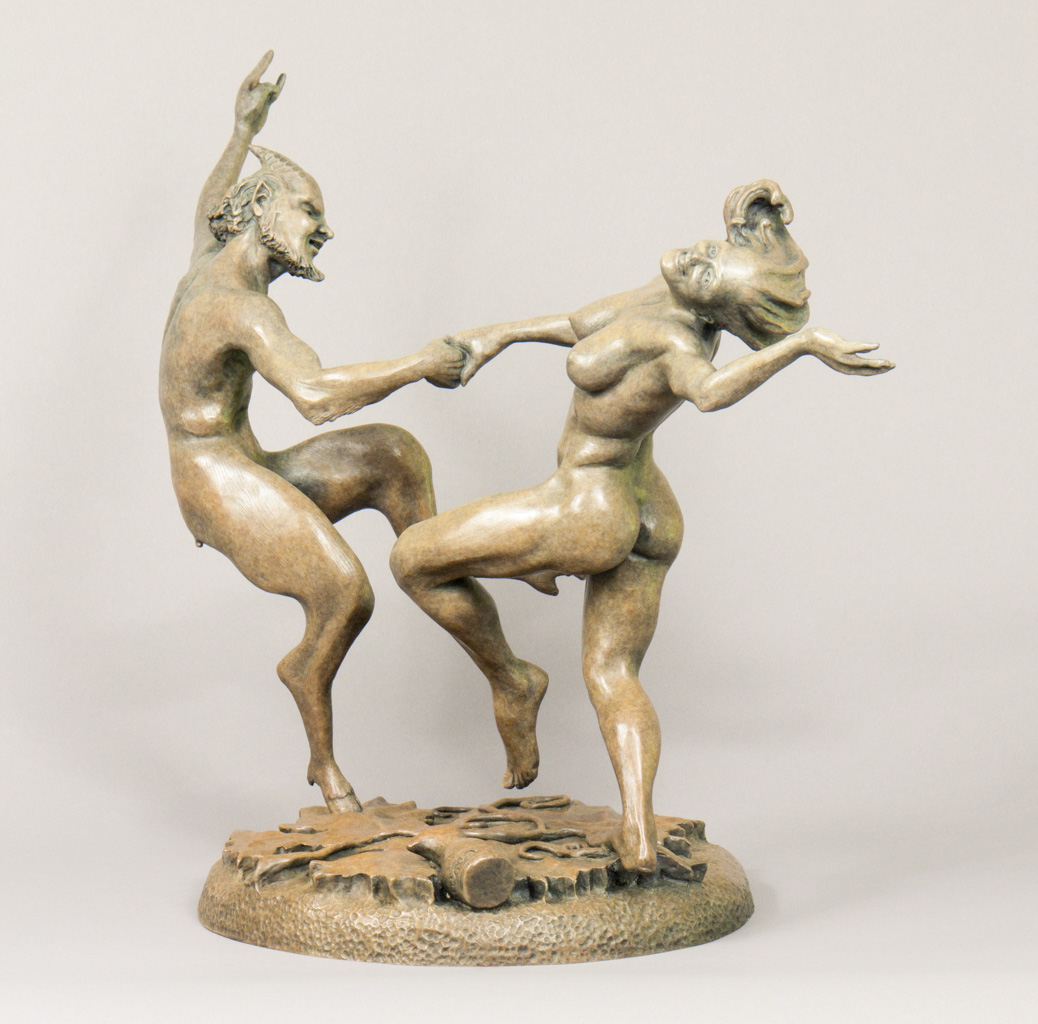
The hardest thing in figurative sculpture is the other eye.
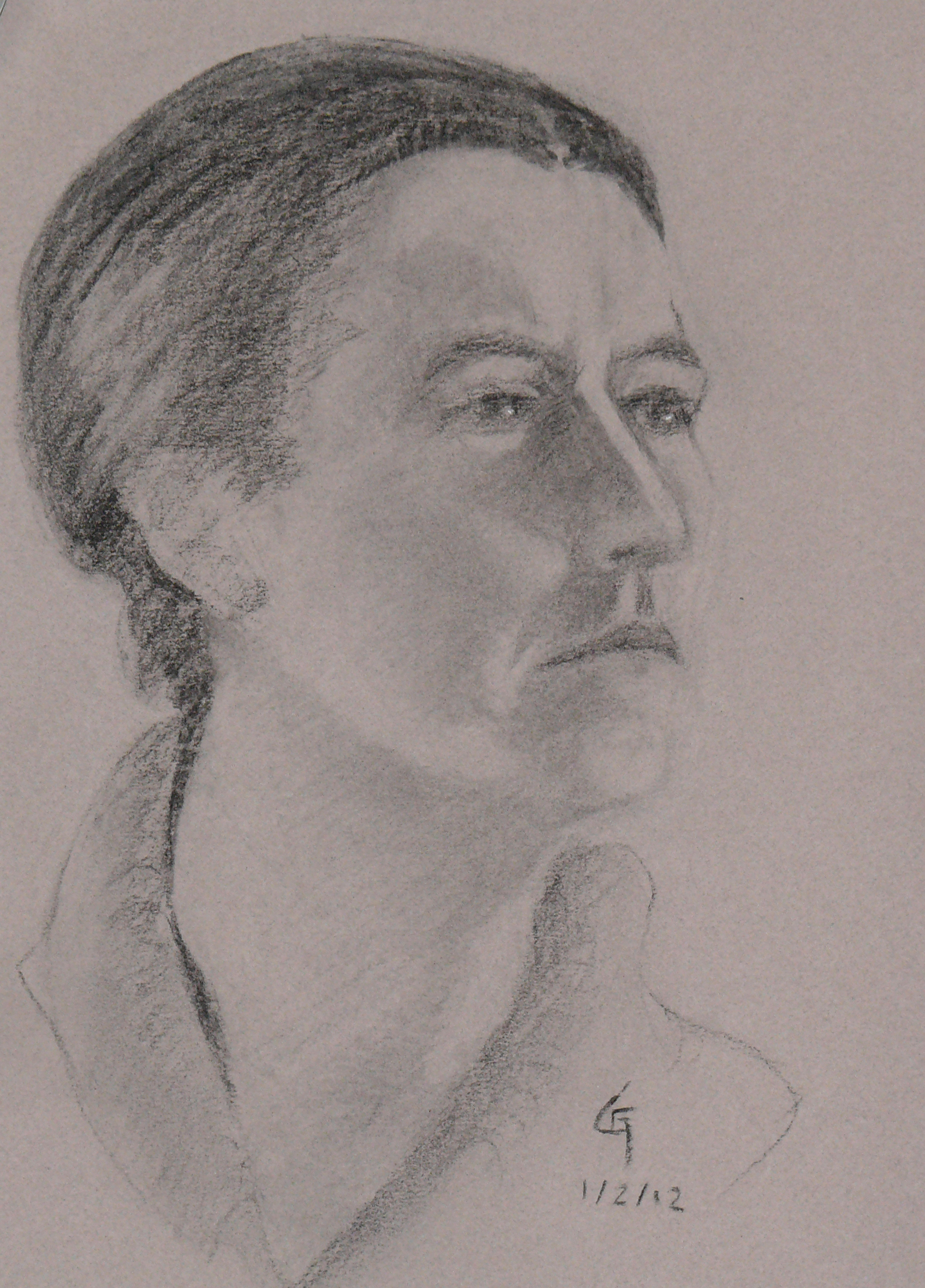
Note how the neck moves forward out of the body to intersect the head at an angle. For a standing figure, the three containers slope as follows: the head is forward, the torso slopes back, and the pelvis slopes forward. Together they define a beautiful S-curve. To understand the position of the ribcage, look at the nipples and lower ribs. The shoulders move independently, so don’t get fooled by them. Especially for the containers, add and remove material symmetrically. The pubis is the midpoint of the classic 7.5 head-high figure and a seated figure rises about 4 heads above the chair. For the head, pay particular attention to the tear ducts, which bisect the head from top to bottom, and the ears.
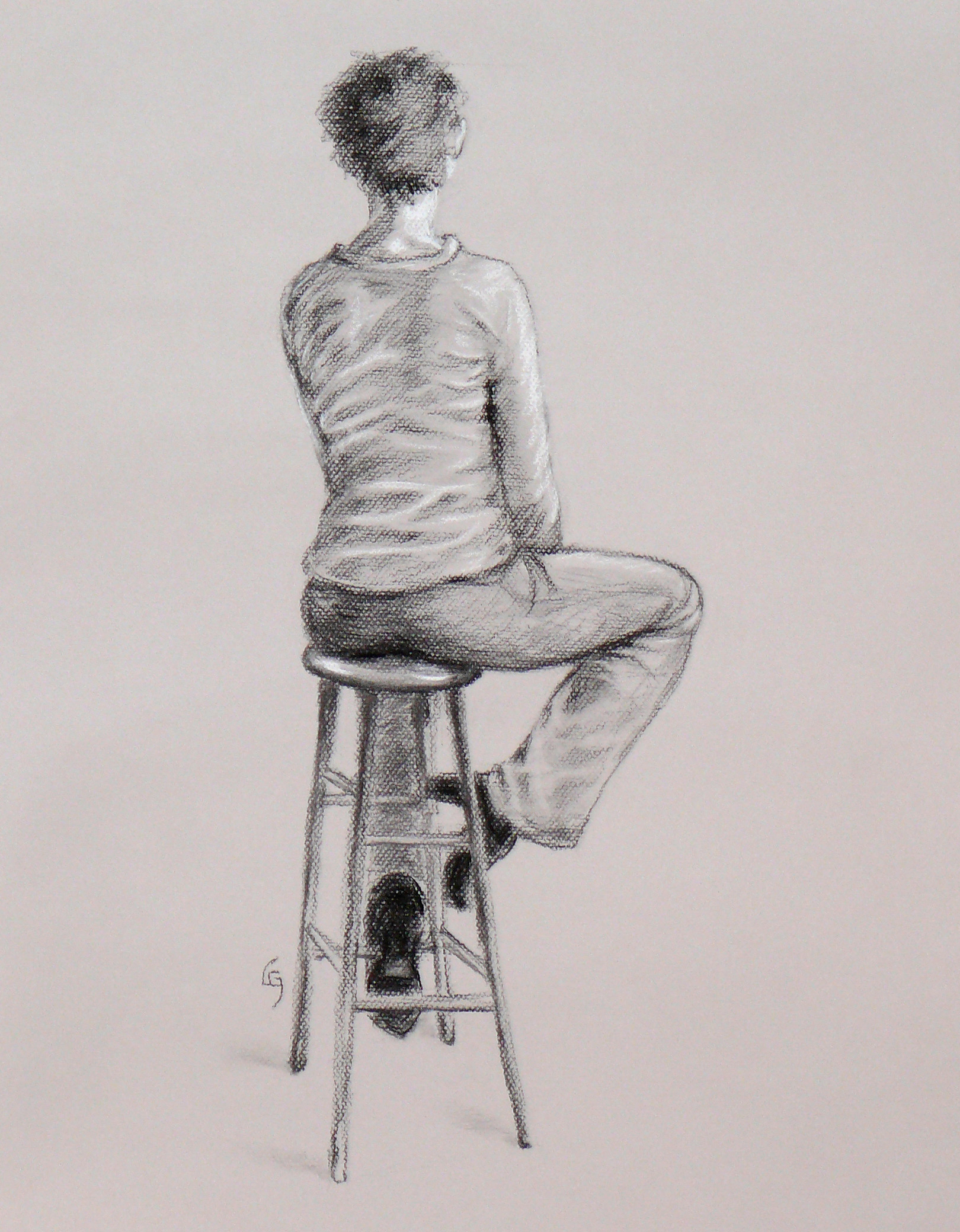
Breasts can be firm or not, but they are not muscles, nor are they covered by muscle, despite what my wife thinks.
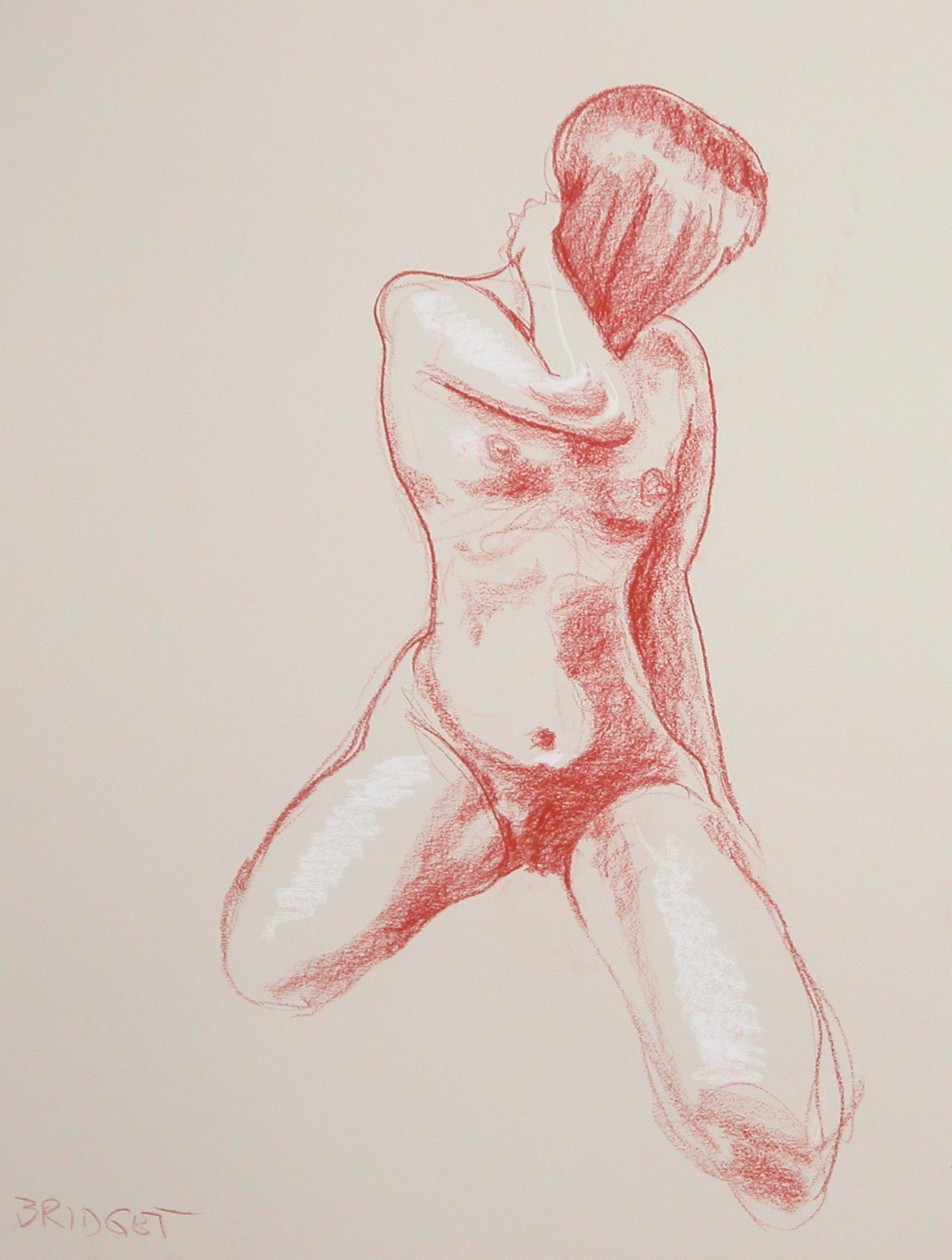
If someone hurries a sculpture, the ears often tell the tale. Ears and knees are challenging. Who put that gnome in the kneecap anyway?

Figures that are alive are convex because of blood pressure (per Rodin). But if you are into horror, note that dead figures have concave surfaces. Unfortunately, most sculpting tools tend to create concave surfaces. Philippe Faraut has a “Clay Modeling Eye Tool” that has a good shape for eyes and much else.
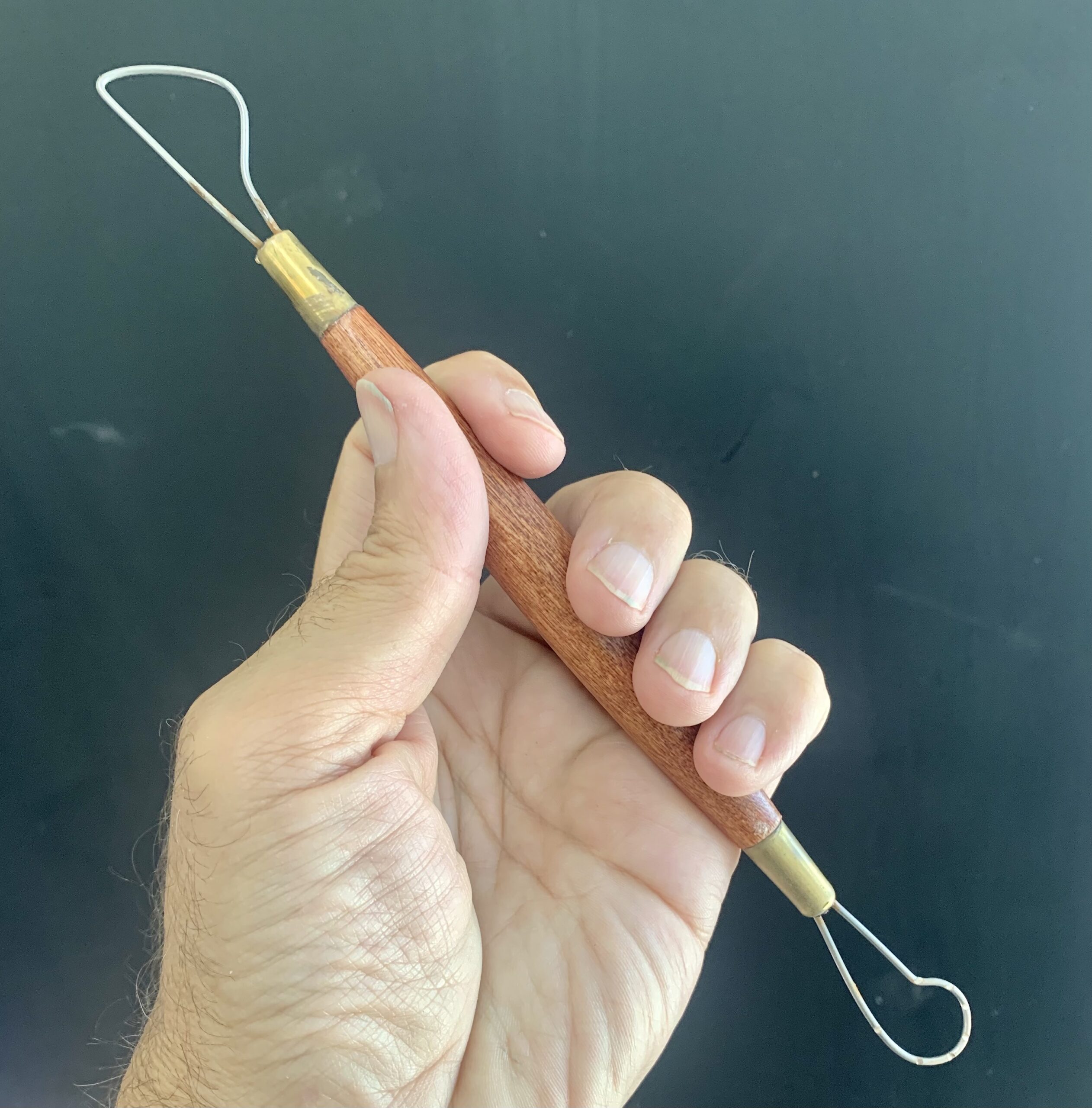
From the front, the widest part of a male figure is in a different place than a female figure. The widest parts of the hips are in different places too. Fat too accumulates in different places male to female and in a different place in an pre-menopausal female than post. As every teenager knows, the genitals mark the center of the body as seen from the front.
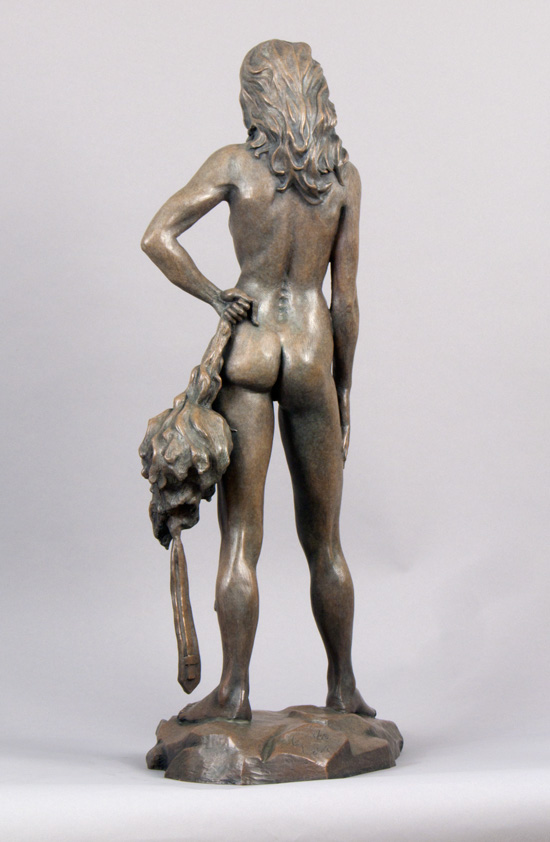
There are no straight lines. Legs and arms are not straight. Muscles should be layered in based on your anatomy studies. Muscles connect one part of the body to another to move them relative to each other. Muscles do not connect one part of a bone to another part of the same bone.
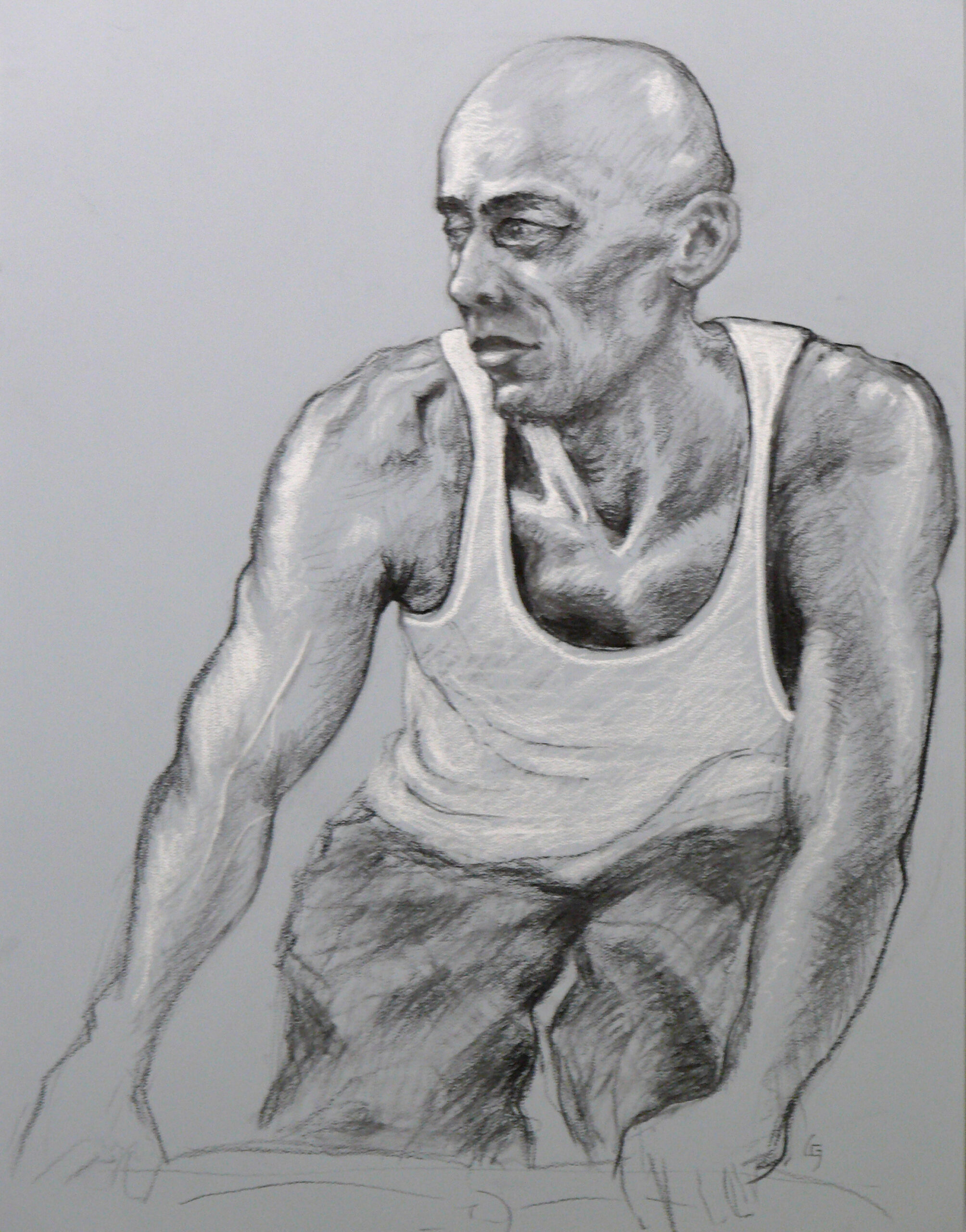
Beauty for Figurative Sculpture
Humans perceive symmetry in other humans as attractive, probably because symmetry and health are often related. For instance, someone who has had a stroke often appears asymmetric.
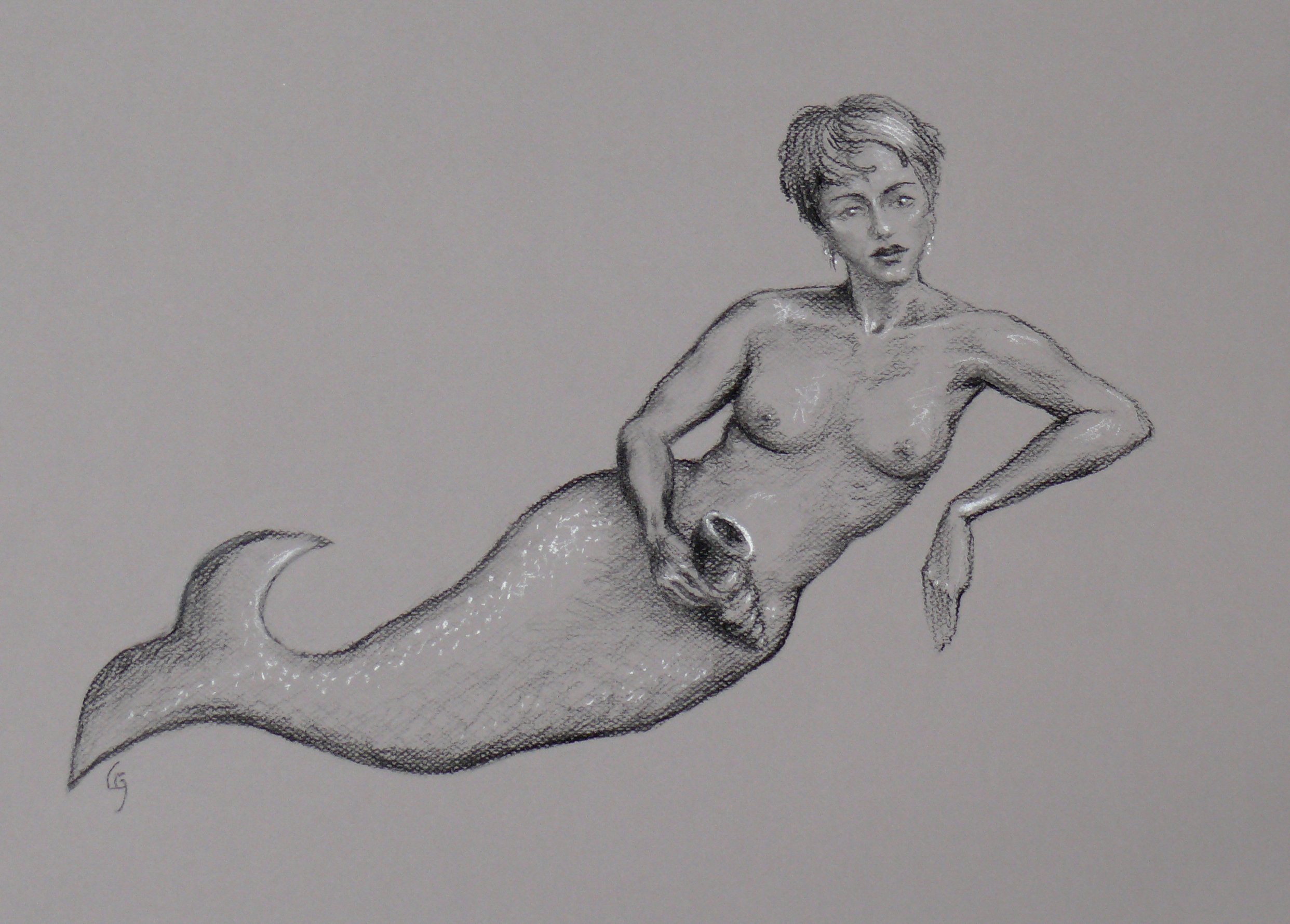
A normal figure is 7.5 heads tall. A heroic figure can be larger in terms of the number of heads high. A larger head detracts from perceived beauty. Longer legs add (think high heels or pointe).
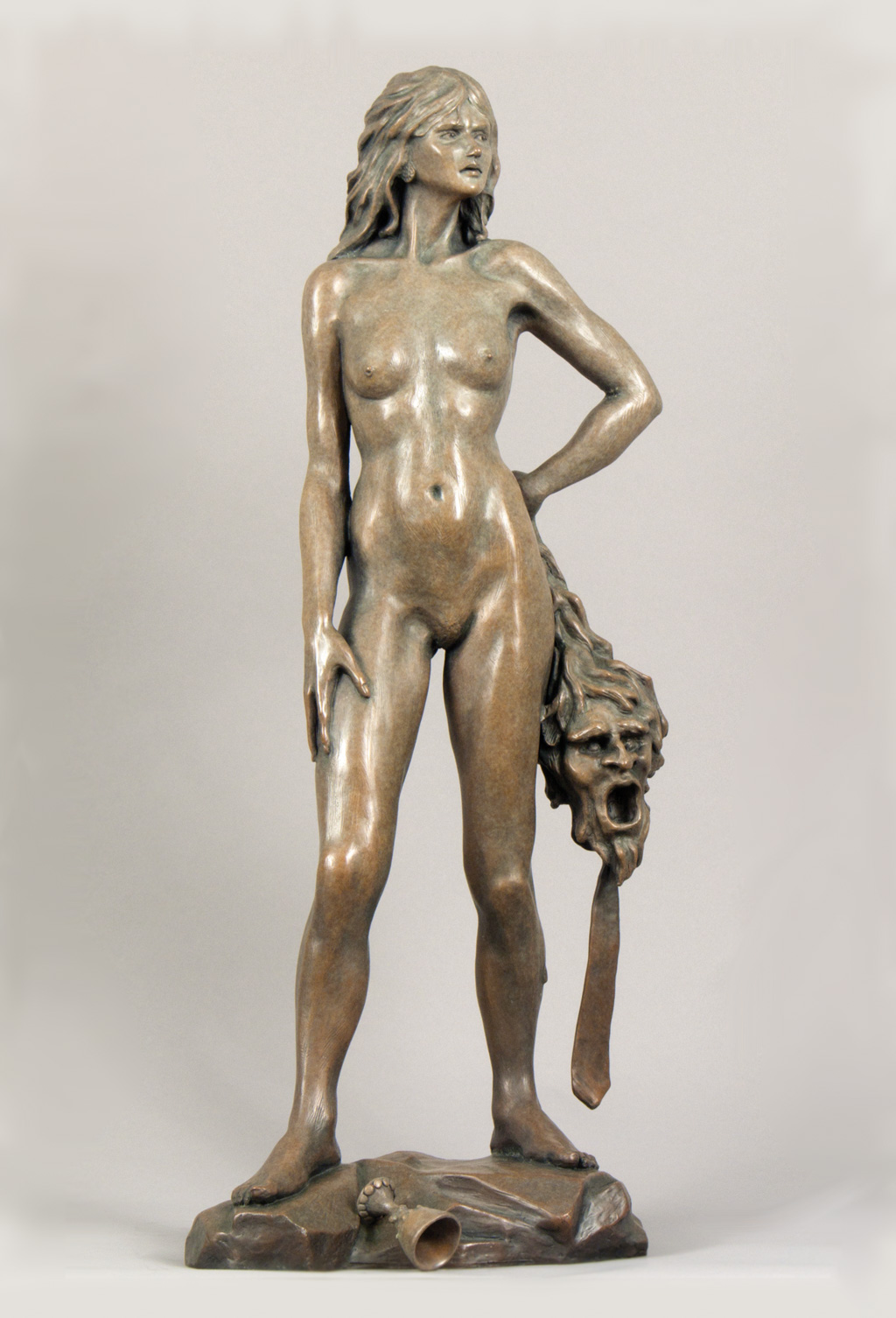
Clay for Figurative Sculpture
Weight of clay goes up as cube of the linear dimension, so bigger sculptures need a LOT more strength than smaller ones. Life-size sculptures (note bronze shrinks about 4% in the linear dimension when cast) have a different feel to them than the same sculpture done small because we tend to relate to the sculpture more if it is life-size. Heroic size sculptures (about 120% of life size) feel, well, heroic. On the other hand, the cost of casting bronze also tends to go up as the volume of the sculpture. Thus, a heroic figure might cost 70% more than a life-size figure, ouch!

While there are hundreds of types of clay, there are three types of clay that I typically use. Water based clay is the least expensive and the smoothest. Sculptors such as Bruno Lacchesi and Philippe Faraut typically use water-based clays. It can go in a kiln, but of course the armatures must first be removed.
Plastilina is a clay that also incorporates oil and wax so that it doesn’t dry out. There are sulphur-based versions such as Chavant Roma. The sulphur makes them smoother, but of course it has an odor and interacts badly with some types of casting rubbers such platinum cure silicone. Richard Macdonald typically uses this type of clay. [update: the newer versions of this clay avoid the Sulphur.] Sulphur-free clays such as Classic Clay are a little less expensive and work better with tin-catalyzed molding rubber. I believe that Paul Moore used Classic Clay for his Oklahoma Centennial Land Run Monument.
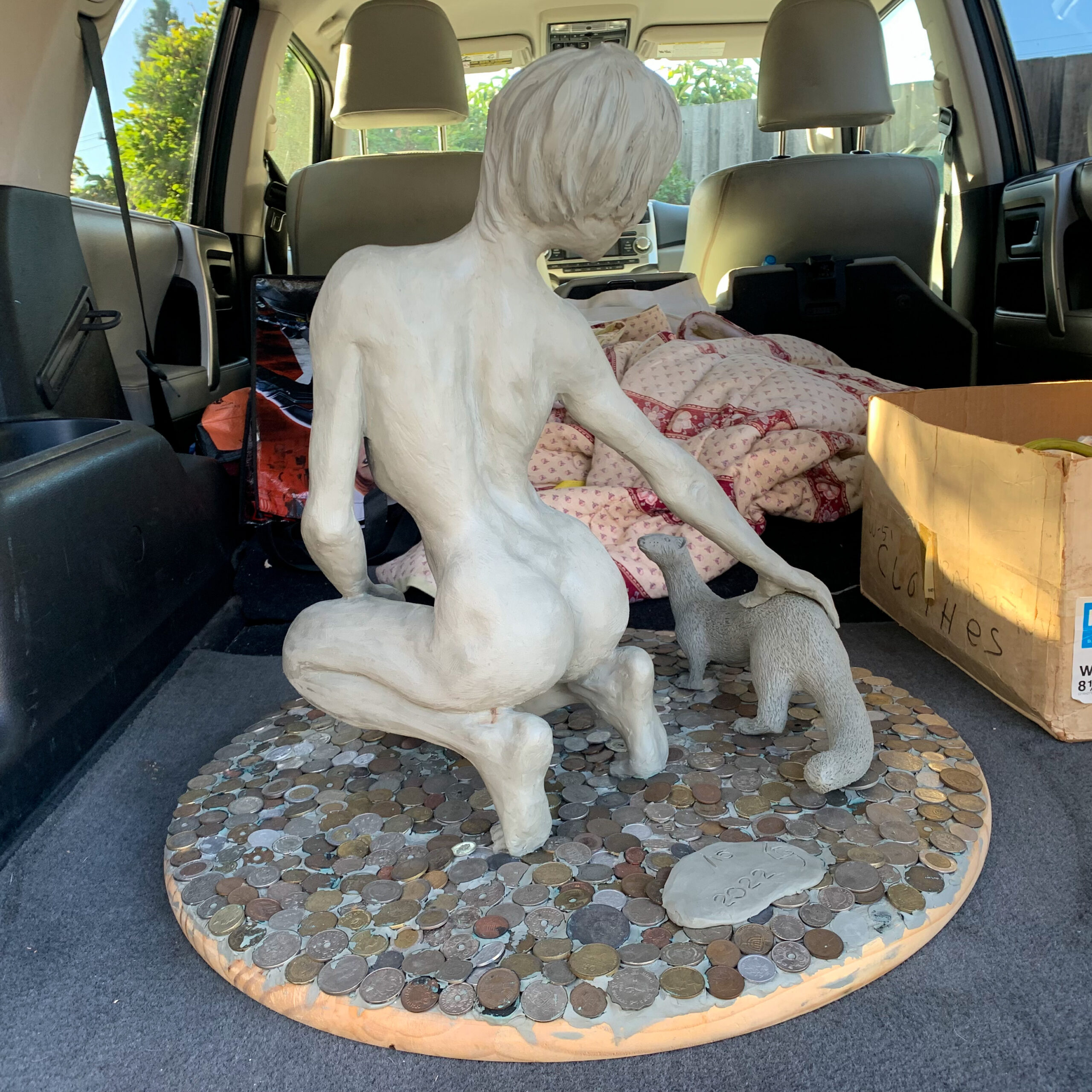
Crinkled aluminum foil dipped in molten clay and then cooled can make a great low weight stuffing for body cavities. Don’t burn yourself.
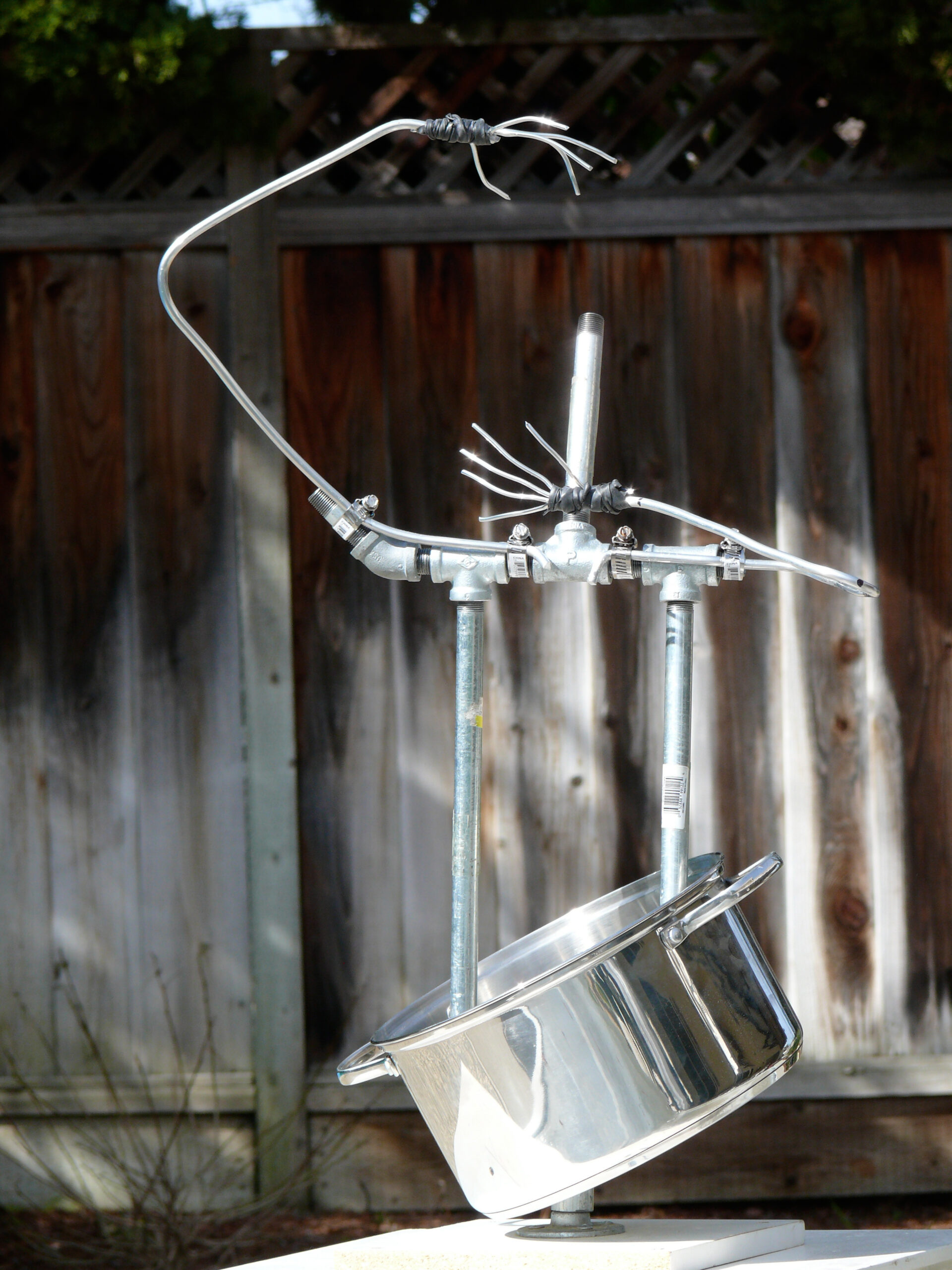
Order of Operations and Mechanics for Figurative Sculpture
Think early about how the final sculpture will be mounted, e.g., on marble, wood, freestanding. If the final sculpture is to be bronze and will be displayed outside, then it needs weep holes for the rain to drain out of areas where it would otherwise collect, and the bottom of the sculpture needs to have some sort of opening that will let the water drain out.
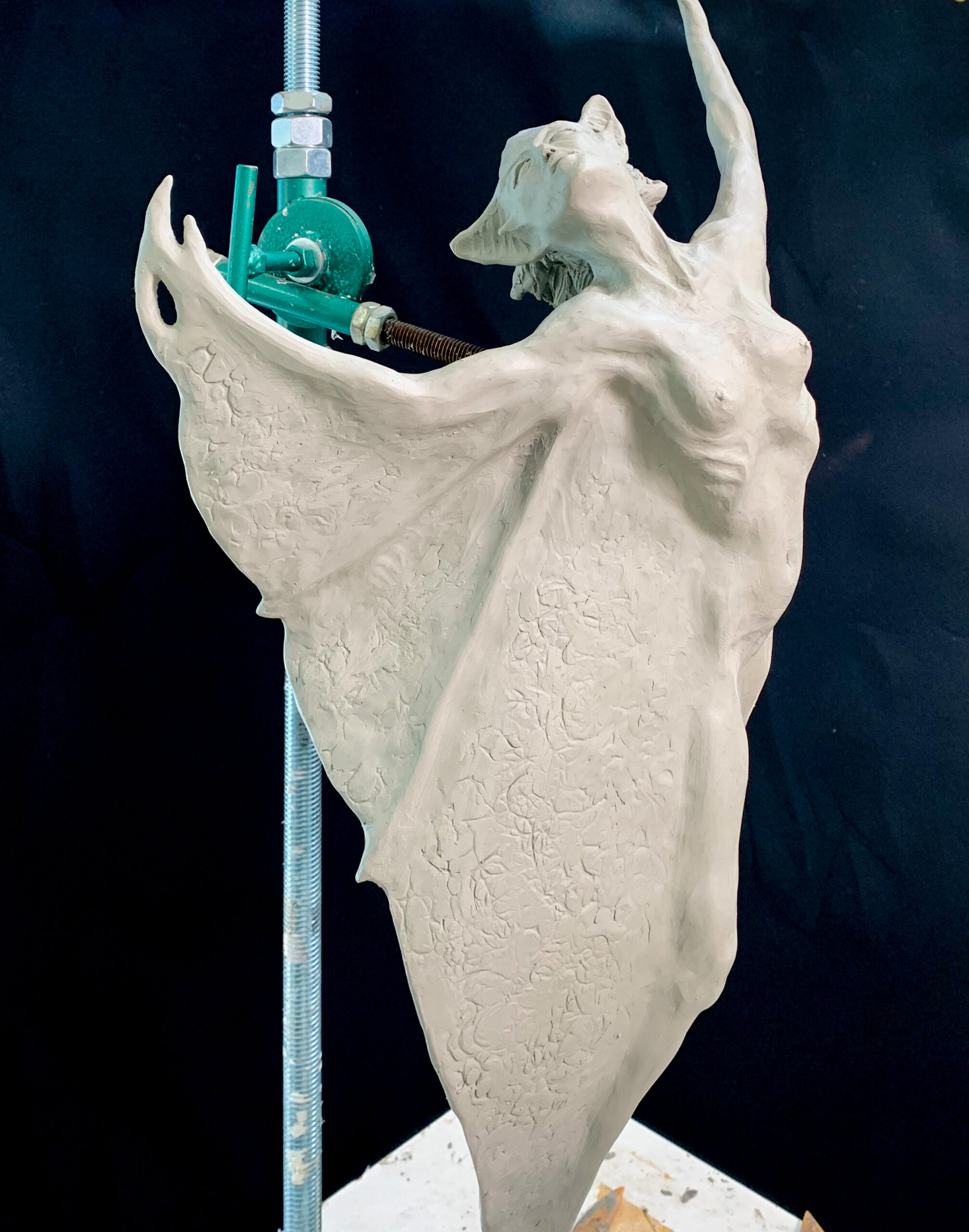
It is easiest to fix something in clay. Then in wax. Hardest in metal.
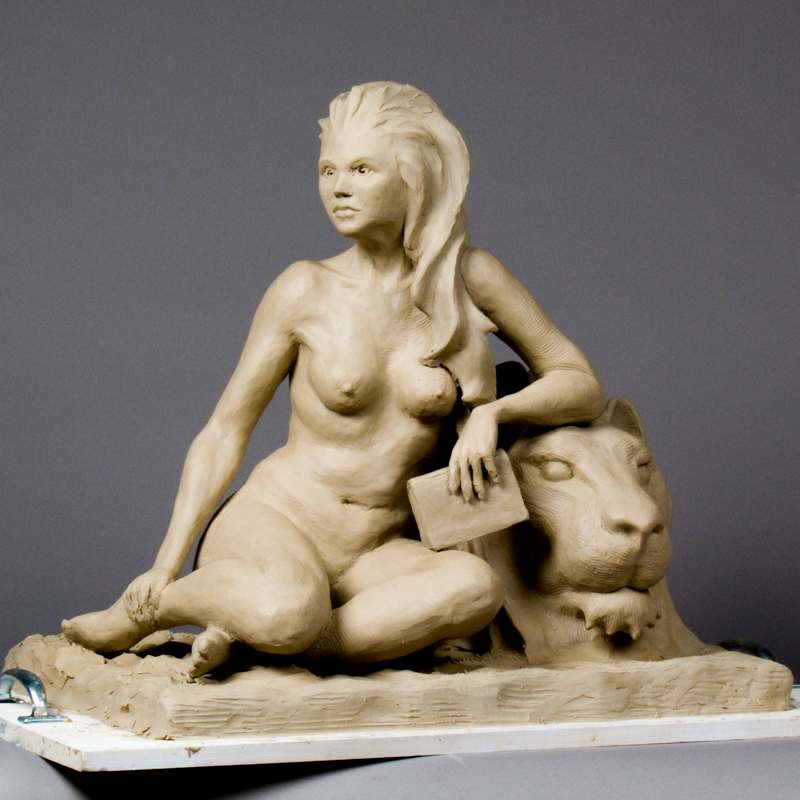
Keep walking around the model. Keep turning the clay. You are not painting a 2-D picture. Don’t get fixated on one view. Your sculpture is supposed to look great from all angles.

Sculpt from large features to small. The gesture should always be visible. This is when you want to be defining sharp planes. Don’t get lost in the details when the proportions are not yet correct. The resulting need for major rework causes artists to cry. Or worse yet, accept the situation and not go back and do the major rework. Bronze work needs to be “WOW” or don’t bother.
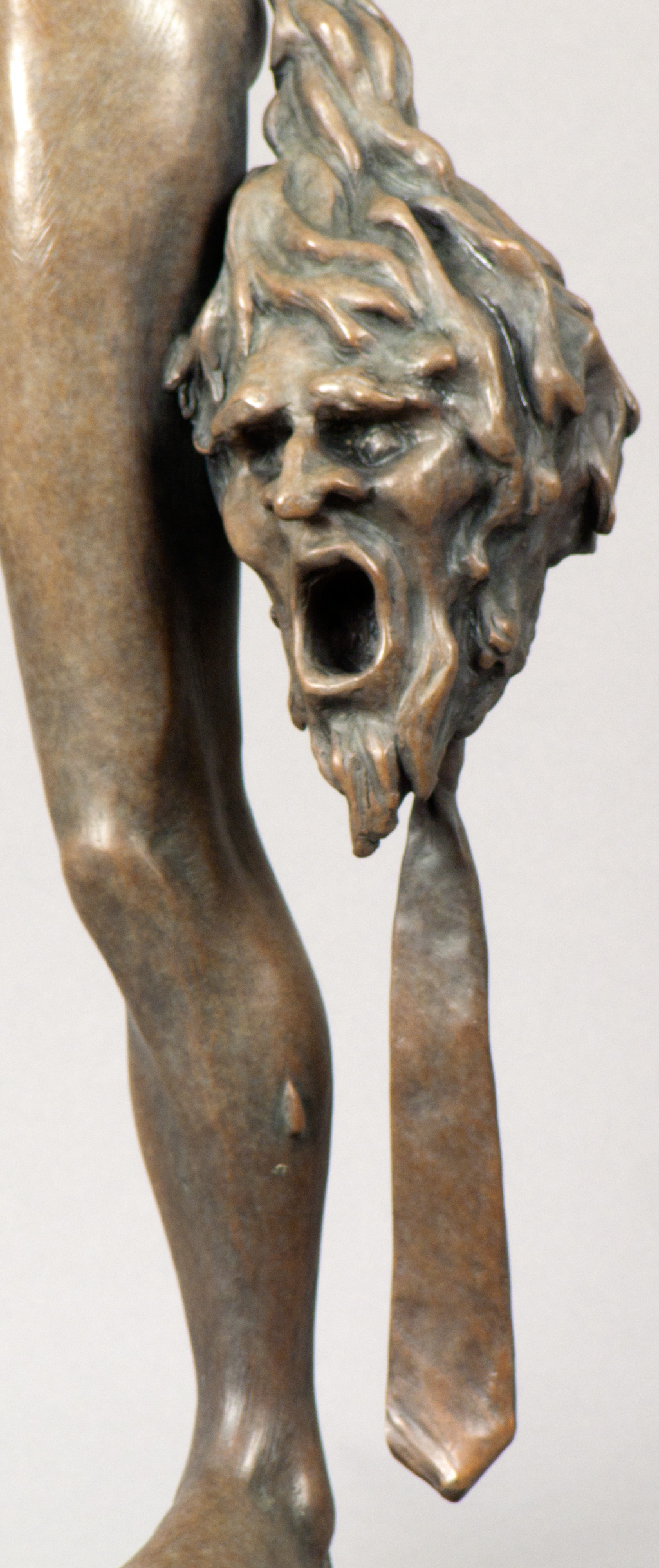
After staring at your sculpture for days and weeks, you need the ability to look at it with fresh eyes. There are a couple of very effective ways to do this. One is to use the trick that painters use, which is to look at your work in a mirror. For some reason, the brain sees it as “new,” and you will discover all sorts of issues. Another way is to photograph the sculpture and look at it (with and without digital mirroring) on the computer screen. It is less immediate but works irritatingly well at showing you what the customer will see. (Use a long lens, 80 mm or more, to minimize distortion.) A good sculpture must work from all angles.
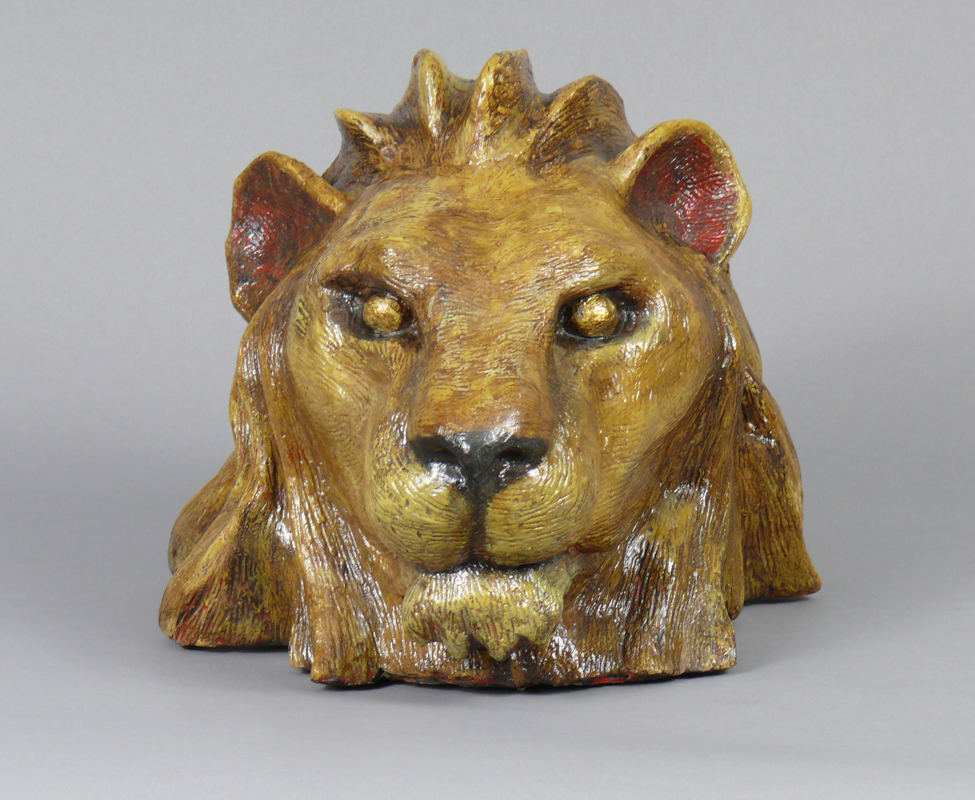
Sculpt the eyes last or they will look at you, draw your attention, and mess up your perception of the rest of the figure. Same goes for the breasts. A female figure should look female before you add breasts. The areola of erect nipples is heavily textured.
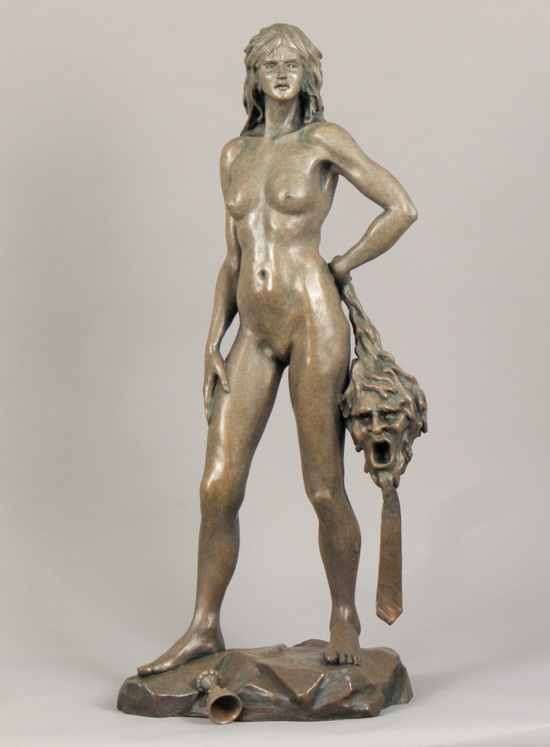
The Model
To model the figure in a dynamic pose takes a lot of work since the model cannot hold the pose for very long. In extreme cases they can just move through it, and you must capture it in your mind. First, one must get the angles and major proportions correct, as discussed earlier. This provides the foundation of the work. Then the trick is to go part by part, returning occasionally to the whole figure to make sure the gesture remains solid. Thus, one works the hand, then neck, then left arm, etc. Supports and hard pillows for the model can even be used. Vertical poses can be done horizontally, until the last finishing touches. And, if the model allows it, photography can help. Respect your model.

The difference between a medical doctor and a sculptor is that the doctor is allowed to touch but not stare while the sculptor is allowed to stare but not touch.
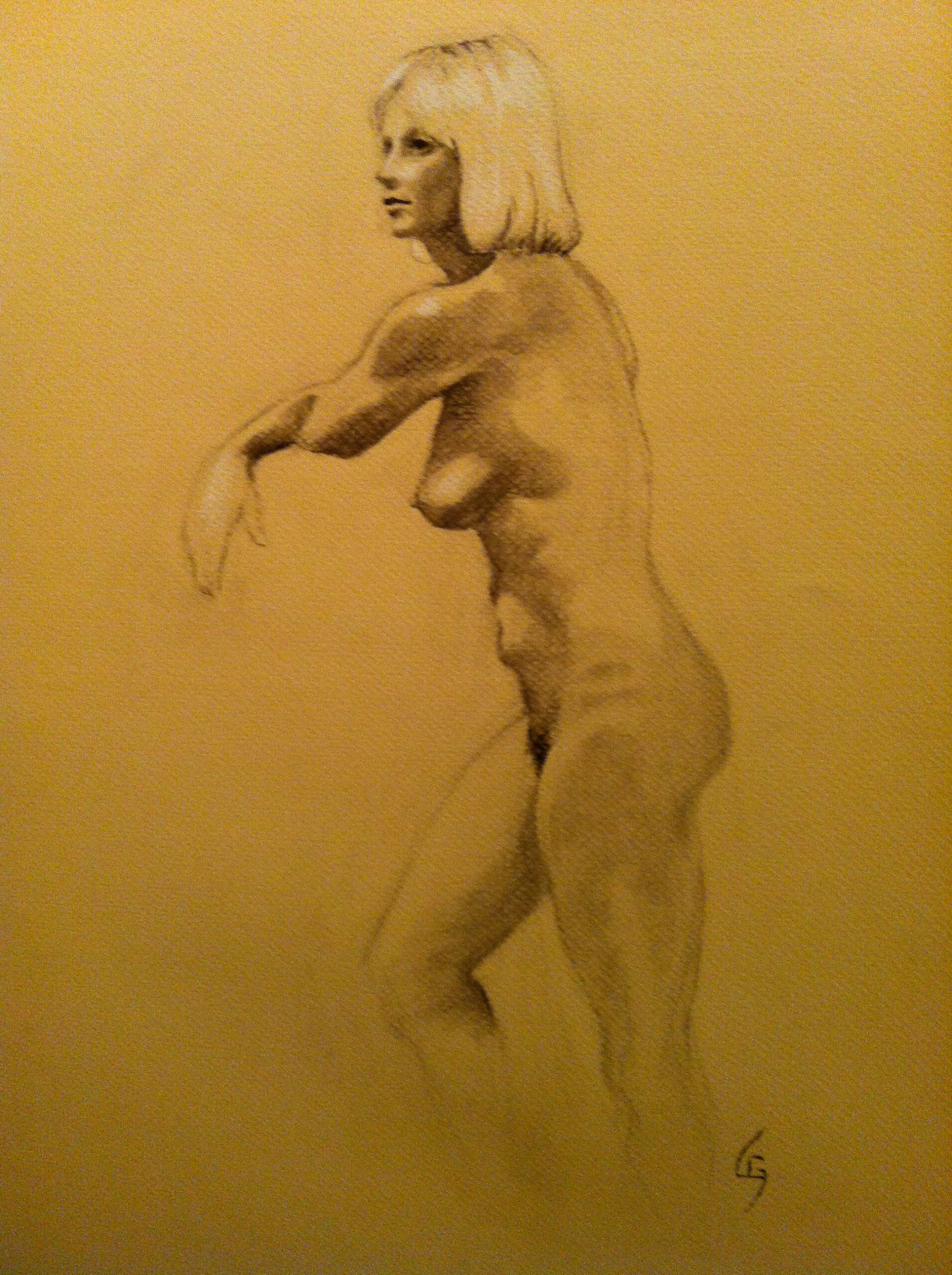
Do not photograph the model without permission, and if you do get permission to take reference photos, they must never ever leak to the Internet.
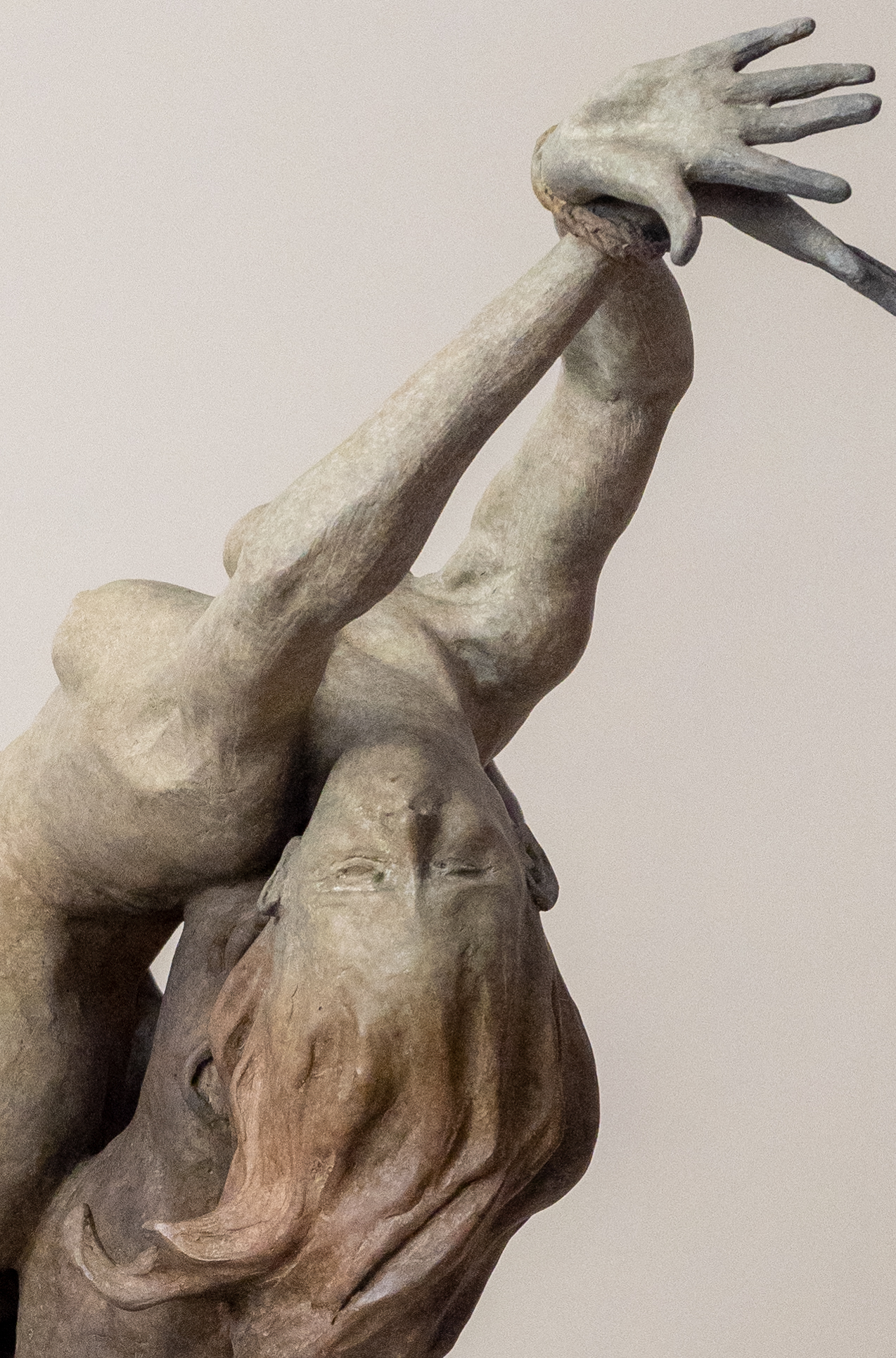
Sculpt from live models whenever you can. It is difficult to walk around a photo. Note that different muscles pop when active than when resting.
To give you a feeling of what goes into making a piece like the one to the right, first imagine what the poor model had go through to hold anything like this pose. It won’t surprise you to learn that she is an accomplished yoga instructor. To help her we built a whole set of scaffolding to help her hold the pose. Part of it included a sling for her raised left leg. At one point I told her that we were done with that set and she lifted her left leg out of the sling. I then yelled “STOP,” because when the leg was under tension, as opposed to resting in the sling, her rectus femoris popped near where it connects to the ilium. I made her hold that for a few seconds so that it was correctly captured in the clay. Getting dynamics like that right are what separates good from great. And why talented models with a great attitude are so critical.
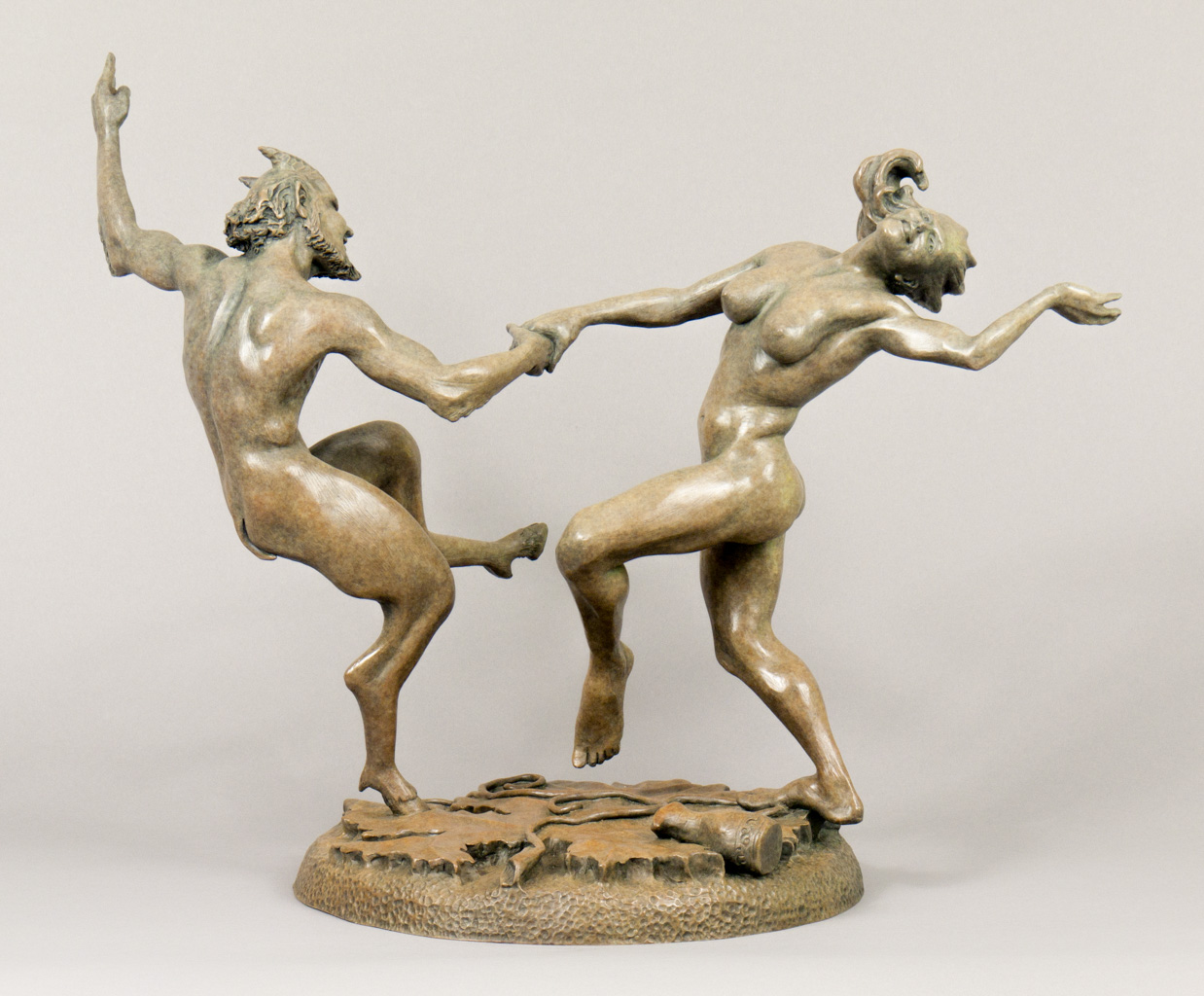
Other Elements of Figurative Sculpture
Watch out for sharp points and power tools. Losing an eye is bad for visual artists. If you shortcut safety you may have a long stay in the hospital to contemplate with regret the five minutes you “saved.”

If you have a side brace coming into the armature, as is common for a standing model, make sure it intersects the figure at a place that is not complex. E.g., don’t have it come out of the spine area.
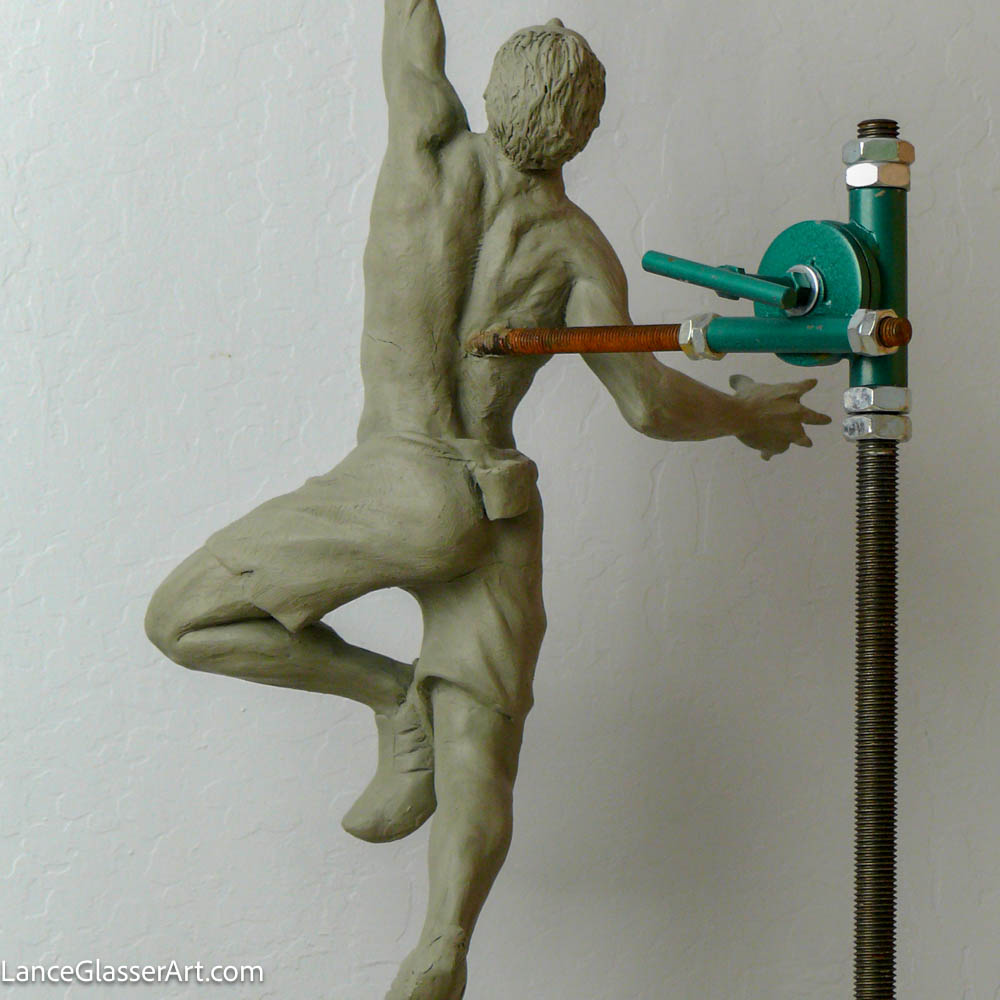
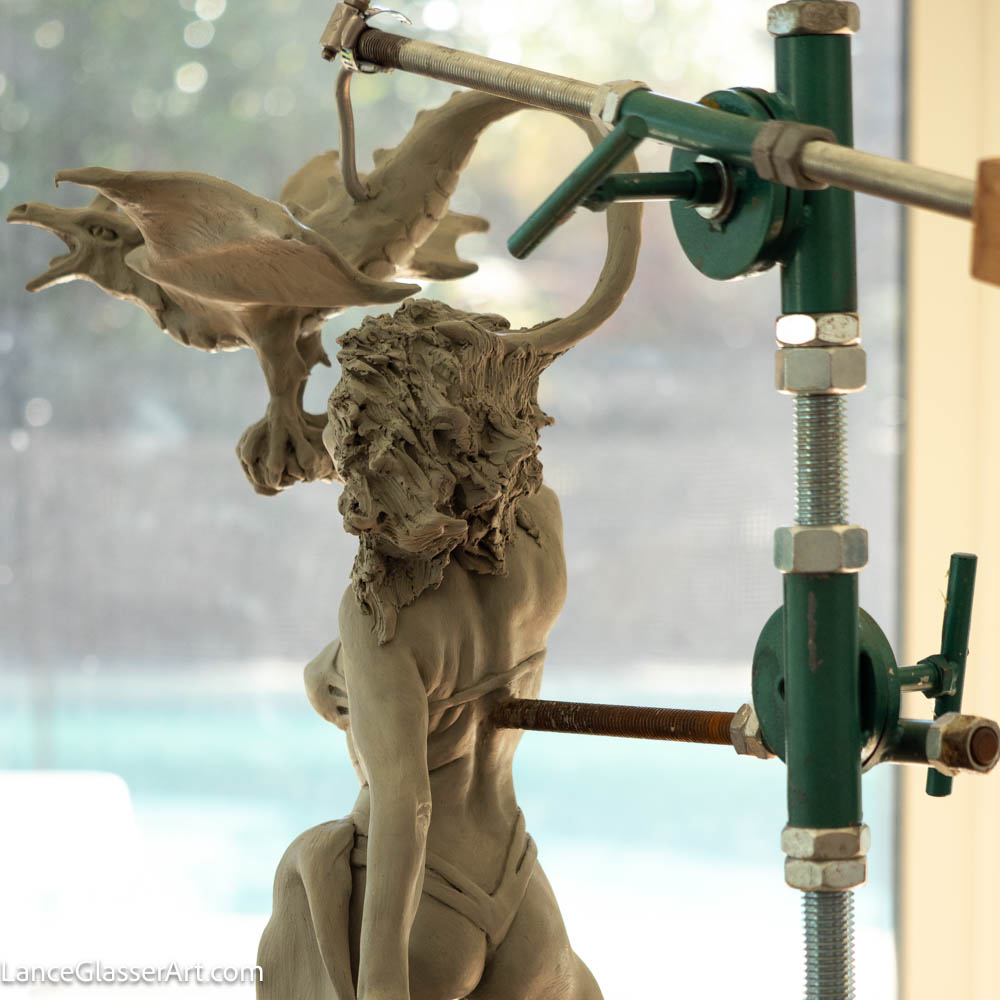
Be constantly looking for candidate poses as you look around every day. Keep your artist-eyes open. If you see something, photograph it so that you don’t forget.

Auguste Rodin once said, “A sculpture is a series of silhouettes.” He also said that “The silhouette is the most important part of a sculpture. It is the first thing that the eye sees, and it should be the most expressive part. The silhouette should capture the essence of the form, and it should be simple and elegant.”
One can use this to improve one’s sculpture. For instance, a single strong light 3 to 5 meters away from the sculpture (or model) can be used to show off curves with high contrast.
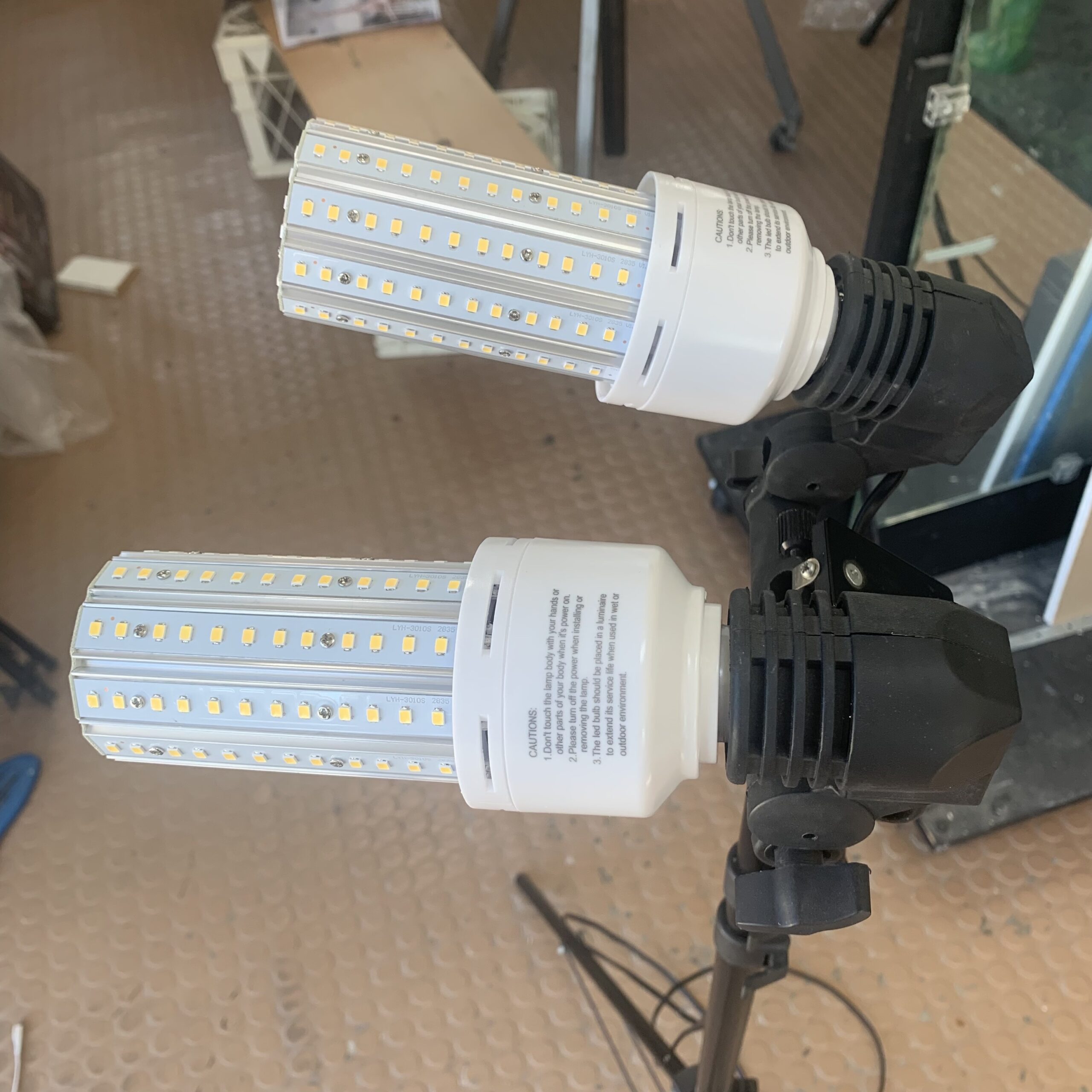
Sometimes you need the clay to be a little firmer in order to sculpt the finest features. One way to accomplish this is to make the clay cooler. This can be as simple as putting it in a refrigerator. An effective technique is to get a can of compressed gas dust remover. Hold the can upside down and spray it on the area that you want to cool down.
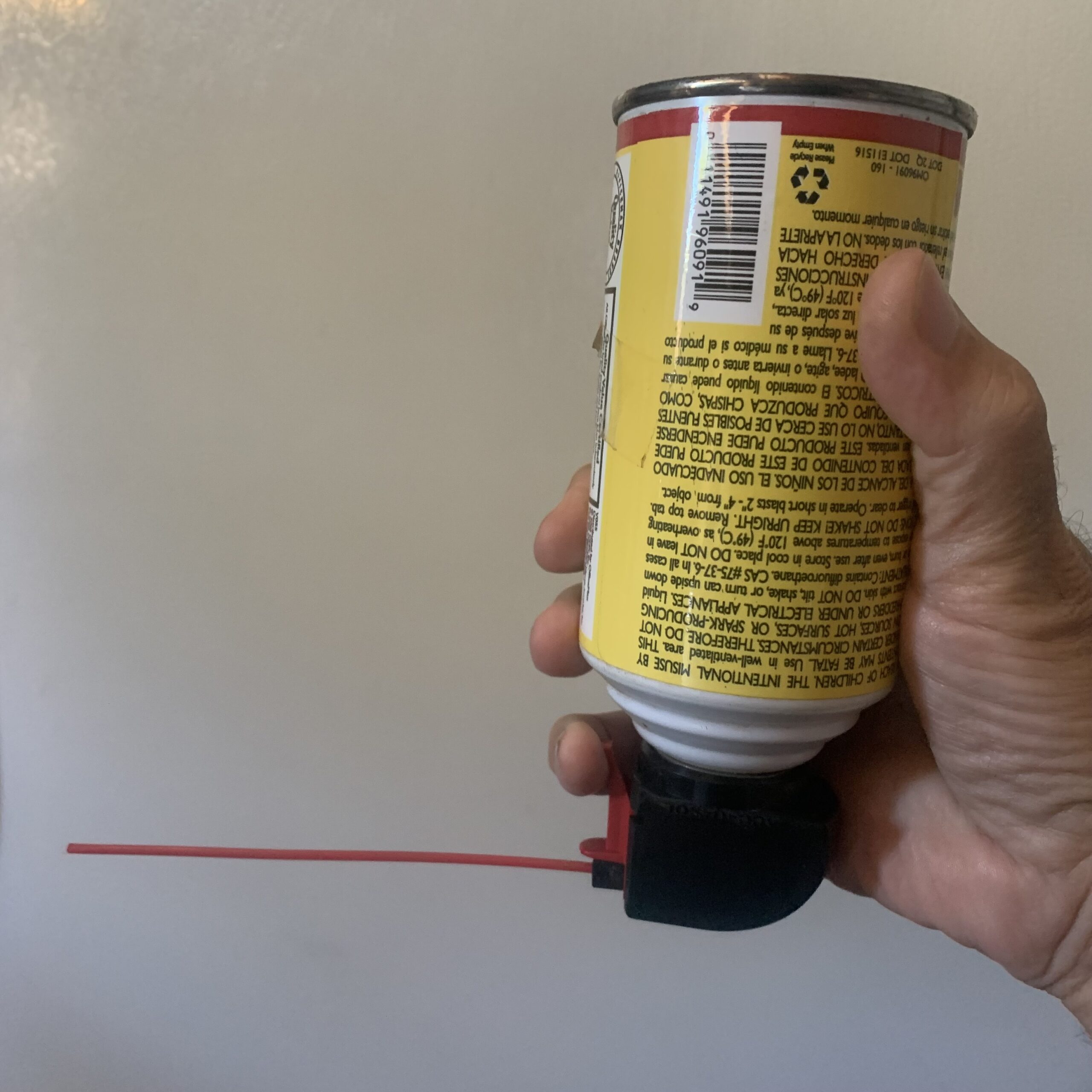
And remember, in art there are no rules.

